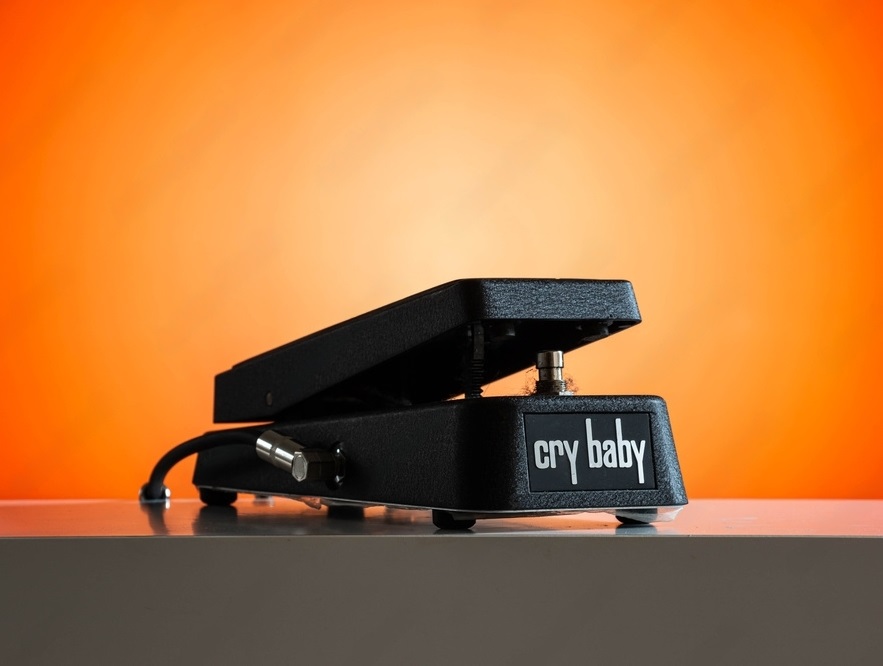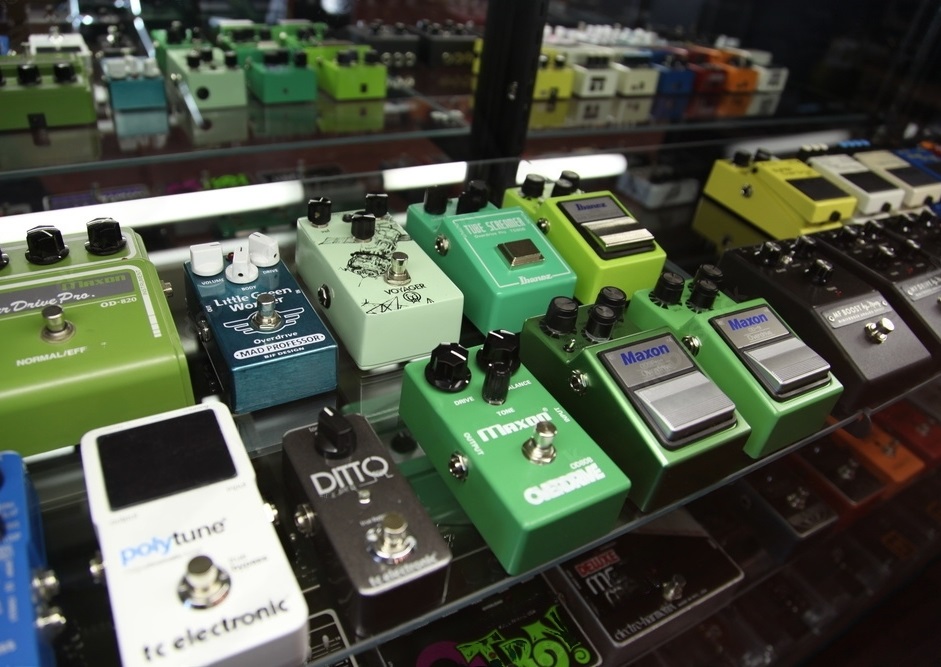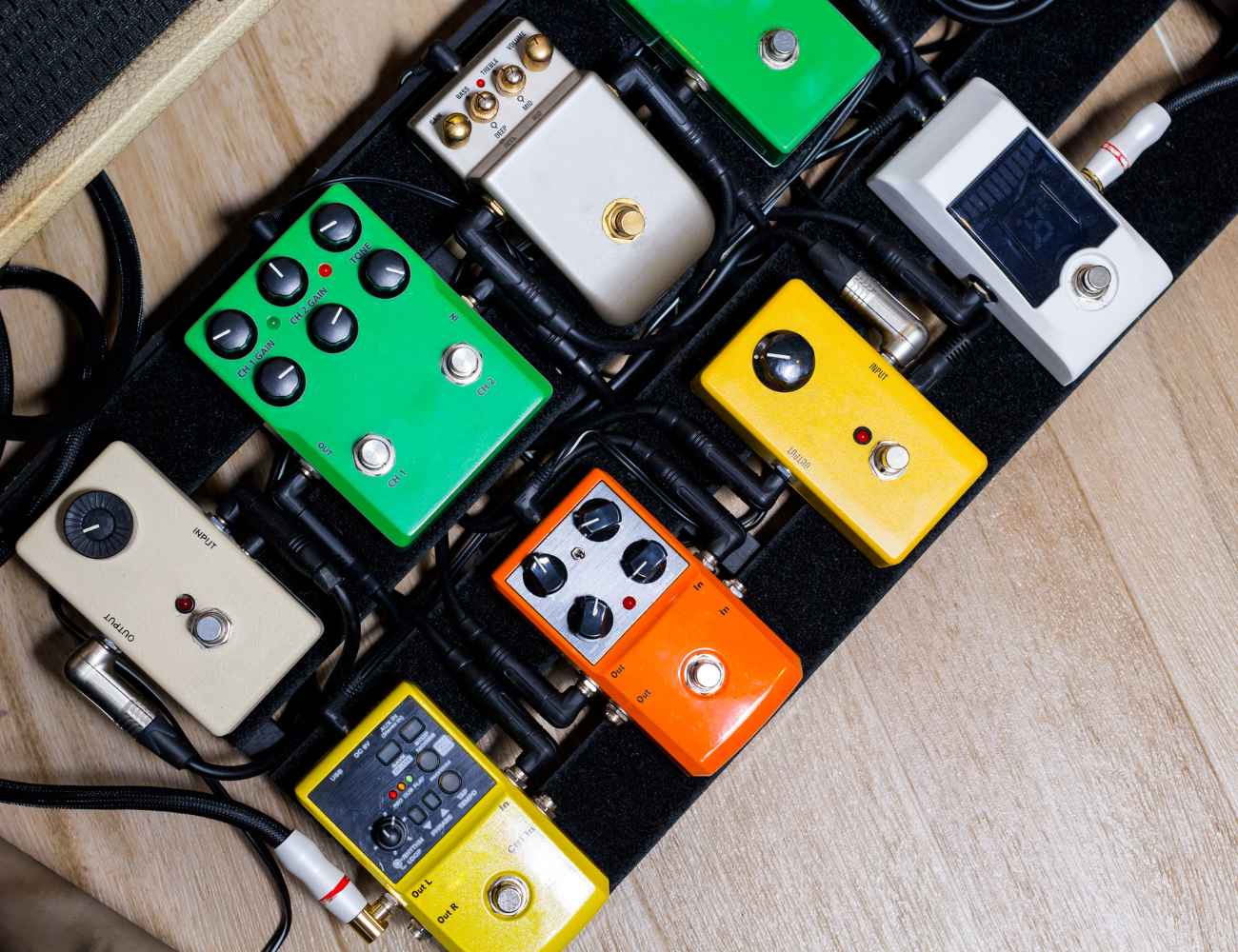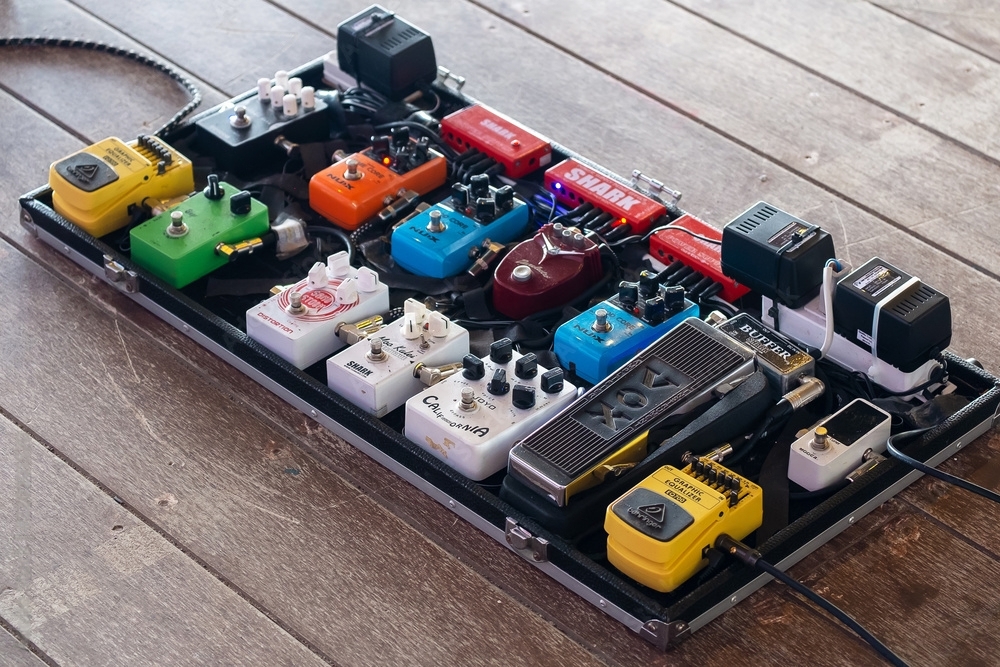Ever thought about how to make your guitar solos sound more like Jimi Hendrix or Eric Clapton?
The secret sauce could very well be a good and versatile wah pedal.
These small, foot-operated devices can drastically change your sound, infusing your music with an unmistakable, voice-like quality.
In this article, we will dive into the world of wah pedals, exploring their uses, various types, and how to choose the best one for your needs.
Aside from that, I’ll also go over some frequently asked questions so that you can have a better idea of what to expect when buying a new one.
Table of Contents
- Best Wah Pedals
- Dunlop 535Q Cry Baby Multi-Wah Pedal
- JOYO WAH-II Classic Wah Pedal
- Vox V845 Classic Wah Pedal
- Xotic Effects XW-1 Wah Pedal
- Behringer Hellbabe HB01 Wah-Wah Pedal
- MXR MC404 CAE Dual Inductor Wah Pedal
- Fender Tread-Light Wah Pedal
- Hotone Soul Press Mini Wah Pedal
- Vox V847A Wah-Wah Pedal
- SONICAKE Active Volume & Wah Expression Pedal
- MORLEY 20/20 Bad Horsie Wah Guitar Effects Pedal
- JIM DUNLOP Justin Chancellor Cry Baby Wah
- Mooer Audio The Wahter Wah Pedal
- Boss AW-3 Dynamic Wah Pedal
- Ibanez WH10 V3 Wah Pedal
- Boss PW-3 Wah Pedal
- JIM DUNLOP Standard Wah Pedal
- What exactly is a wah pedal?
- What should you consider when choosing a wah pedal?
- How to use a wah pedal?
- How to order pedals on a pedalboard?
- Boutique vs. Mass-Produced pedals
- How much should you spend on a guitar pedal?
- Can you use a guitar pedal with a bass guitar?
- How to properly power your pedals?
Best Wah Pedals
Before I begin, here are my top selected choices:
Vox V845 Classic Wah Pedal

Legendary Wah-Wah tone in a durable, affordable pedal. Check Price
|
|
Behringer Hellbabe HB01 Wah-Wah Pedal

Optical control, customizable, no-nonsense build quality. Check Price
|
Dunlop 535Q Cry Baby Multi-Wah Pedal
Cry Baby 535Q Multi-Wah: legendary wah sound with adjustable features.
The Cry Baby 535Q Multi-Wah pedal is the most versatile wah on the market, allowing you to adjust the frequency range and center of the effect. Its adjustable boost can add endless sustain to any note. With over 15 models, Dunlop offers the perfect wah for any musician.
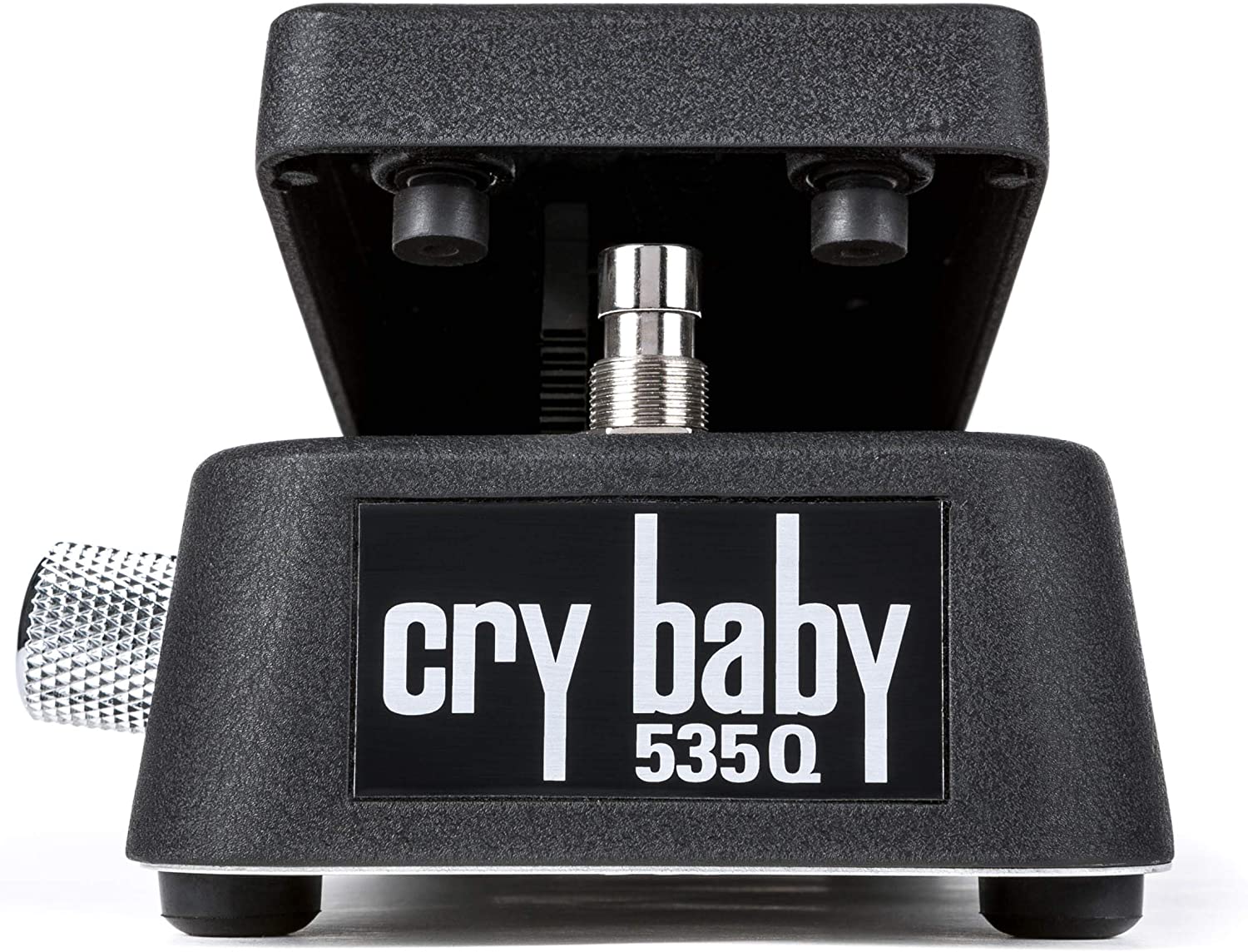
Let’s delve into the heart of the Jim Dunlop Multi-Wah Guitar Effects Pedal.
It’s a versatile piece of gear with exciting features to elevate your guitar-playing experience.
One of the key attributes of this pedal is that it lets you choose the frequency center and range of the effect, giving you a lot more control over your sound than you’d have with a typical Wah pedal.
Bearing the 535Q, this model also includes an adjustable, switchable boost.
So if you need extra power, this can be your go-to.
You can conveniently power this pedal with a Dunlop AC adapter or a single 9-volt battery.
It’s been designed to cater to various playing styles, offering six new guitar wah ranges and a “Q” dial that allows you to sculpt your wah from a narrow, sharp wah to a broad, subtle wah.
Furthermore, it comes with a hard wire on/off switch.
The pedal’s multi-colored design and compact dimensions of 10.9 x 4.9 x 3.5 inches add to its visual appeal.
Weighing a mere 70 grams, this pedal is both lightweight and robust.
- My Review
Having plunged into the thick of the Jim Dunlop Multi-Wah Guitar Effects Pedal, one can’t help but appreciate the degree of control it affords.
Sweeping through frequencies, shaping my sound from the biting edge of a narrow way to the mellow curves of a broader, more subtle wah, felt like wielding a sonic paintbrush.
Likewise, a range of six new guitar wah options was like having an artist’s palette at my feet, the “Q” dial letting me add my personal touch.
Yet, there was a caveat I couldn’t overlook.
The filter sweep range offers a specific band of frequencies it travels through as you rock the pedal, meaning there’s always a targeted range.
It’s a feature that can be both a boon and a bane.
On the bright side, it allows you to zone in on specific sound sections, making it ideal for structured playing.
Conversely, it limits the wah effect on a range of notes, subtly diluting the vibrancy if you’re all over the fretboard.
Physically, this pedal is a robust piece of kit.
The construction quality is solid, from its casing down to the knobs, the on/off switch, and the pedal’s action.
With its colorful design and compact dimensions (10.9 x overall quality, it’s disappointing that no cord or batteries are included.
A minor hiccup, but one worth noting to avoid dampening that first jam session.
One more noteworthy feature is the adjustable, switchable boost that lends an extra layer of power when you need it, and it’s powered by a Dunlop AC adapter or a single 9-volt battery, giving you flexibility.
So, there you have it.
Here are the ratings I’ll give to the Dunlop 535Q Cry Baby Multi-Wah Pedal:
Despite a few minor drawbacks, the Jim Dunlop Multi-Wah Guitar Effects Pedal is a diverse tool, catering to various playing styles with its range of features and solid construction.
It’s not just a pedal; it’s an expression enhancer, allowing you to add that special touch to your sound.
- Pros:
- Provides control over important wah parameters.
- Offers adjustable, switchable boost.
- Features a variable boost from 0 to +26 dB.
- Constructed with solid and durable materials.
- Cons:
- May have occasional quality control issues.
- Some users experienced defects or malfunctions.
- Does not come with an AC adapter.
- Requires additional accessories for full functionality.
My final verdict is that the Jim Dunlop Multi-Wah Guitar Effects Pedal is a highly versatile and feature-rich pedal with excellent tone and performance.
The brand’s reputation adds to its appeal, and considering its overall value, it is a solid choice for guitarists.
However, potential buyers should be aware of occasional quality control issues and the need to purchase additional accessories for full functionality.
JOYO WAH-II Classic Wah Pedal
JOYO WAH-II offers versatile WAH sound quality with adjustable frequency ranges, in a lightweight, easy-to-use package.
JOYO provides innovative and practical music products, giving guitarists the best playing experience possible.
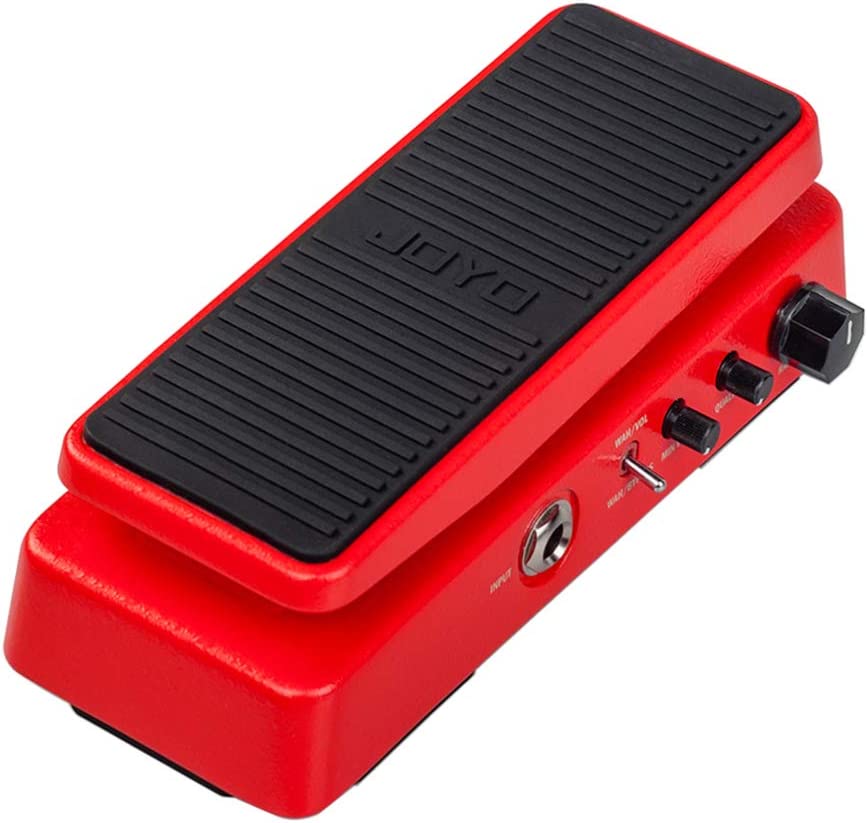
With its elegant design, the JOYO WAH-II Classic Wah Pedal blends the traditional with the contemporary to bring a great effect pedal to the music world.
As a guitarist’s dream, it incorporates a multifunctional WAH and VOL, combining two essential elements in one compact device.
A compact yet solid build gives it durability and longevity.
Crafted to deliver optimum performance, this pedal also provides exceptional volume control with a VOL mode, ensuring you can adjust sound intensity effortlessly.
Beyond just functionality, its attractive LED light offers a clear visual of the working state, making it a breeze to use during a performance.
One of its defining characteristics is the WAH mode, which brings a quintessential wah tone to life, contributing to a richer, expressive sound that can add the perfect touch to your music.
Finally, despite its impressive features, it’s worth noting that it’s powered by a 9V battery or DC 9V adapter, allowing for flexibility in usage.
- My Review
Strapping on the JOYO WAH-II Classic Wah Pedal for the first time was like dipping my toes into a river of possibilities.
Its sleek design captured my attention right away.
Nestled in my hand, it felt sturdy yet compact, embodying an intriguing mix of form and function.
Turning it on, I was met with an impressive LED light.
It added a touch of glam to my setup and served as a useful visual indicator, guiding me through the twilight hours of my musical journey.
Exploring its dual function, I started with the WAH mode.
Like honey dripping from a spoon, it poured out a rich and expressive wah tone that broadened my musical palette.
Finally, here was a device capable of adding a unique flare to my sound, serving as a paintbrush to create more intricate aural landscapes.
Shifting gears to the VOL mode, I was equally impressed.
It was like being handed the reins to a powerful steed, allowing me to control the sound intensity precisely.
Adjustments were smooth and intuitive, like tuning a finely crafted instrument.
Running on a 9V battery or a DC 9V adapter, this pedal added flexibility to my setup.
I appreciated this power option, knowing I could rely on it in various situations.
However, it wasn’t all roses.
Like learning a new dance, its initial learning curve was a slight downside.
Getting the hang of switching between the WAH and VOL modes took some practice.
But with time and patience, it became second nature, much like mastering a complicated guitar riff.
Here are the ratings I’ll give to the JOYO WAH-II Classic Wah Pedal:
Stepping back, the JOYO WAH-II Classic Wah Pedal seemed to strum the chords of innovation and versatility, despite a minor hiccup.
This musical symphony was pivotal in enhancing and enriching my sound palette.
- Pros:
- Compact and portable design
- Multiple wah-wah frequency ranges
- Versatile with wah-wah and volume functions
- Sturdy aluminum-alloy housing
- Good sound quality and tone
- Cons:
- Some users experienced switch issues
- May require additional adjustments for optimal performance
- Size may be too small for some users
My final verdict is that the JOYO WAH-II Classic and Multifunctional WAH Pedal offer a compact and versatile solution for guitarists seeking wah-wah and volume functions.
Its multiple wah-wah frequency ranges, sturdy construction, and positive user reviews provide good value for the price.
While some users experienced minor switch issues, and the small size may not suit everyone, it offers a satisfactory performance and delivers on its promises.
Vox V845 Classic Wah Pedal
Legendary Wah-Wah tone in a durable, affordable pedal.
Vox V845 Classic Wah Wah Pedal provides the legendary Wah-Wah sound from the ’60s in a sturdy, affordable design. It features an AC power connector, battery-saving design, and all-black finish, making it ideal for any pedal board.
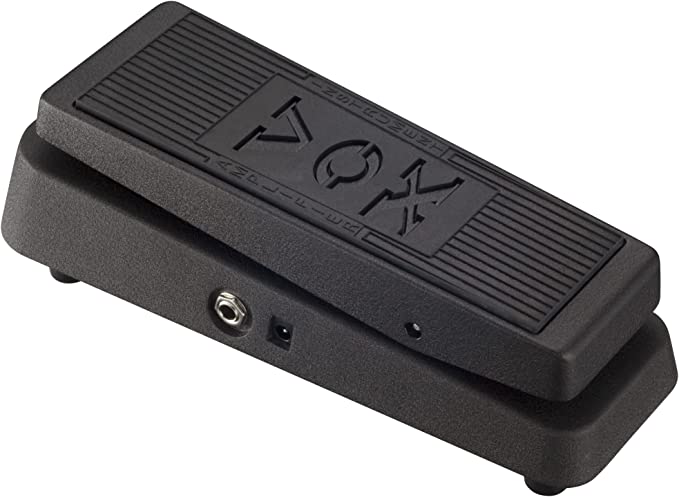
The Vox V845 Classic Wah Pedal it’s modeled after the design that’s been rocking out since the ’60s, delivering the same rich, unprocessed tonal sweep that made its predecessor a legend.
This wah pedal allows guitarists to express their individuality and creativeness, contributing unique flavor to their sound.
Distinct from other pedals, its sturdy chassis is made of black-coated die-cast aluminum, which ensures long-lasting durability and stability.
Furthermore, it’s equipped with a 9V battery, providing power to your musical creativity whenever needed.
Its design incorporates an AC power connector and a buffered input jack to maintain an optimal guitar signal.
One could say that Vox V845 isn’t just about achieving that distinctive sound; it’s about transforming your guitar’s voice in a way that sets it apart.
With its easy-to-control functionalities, this pedal might be your ticket to a new world of sonic exploration.
- My Review
I have to admit, when I first unboxed it, the rugged, black-coated die-cast aluminum chassis gave me a sense of nostalgia, reminding me of the iconic ’60s design.
As soon as I started playing, I noticed the rich, nuanced tonal sweep that adds a special touch to any piece.
Like spices to a meal, it brought out flavors in my music that I didn’t even know existed.
You know what’s great? Having control and the V845 gives me just that.
The simple footswitch control doesn’t complicate things, and I appreciated its smooth operation.
It was like having a new vocabulary for my guitar – each motion, a new phrase or word to add to the dialogue of my music.
But let’s be frank here. While a 9V battery powers the pedal, I did notice it drained quite quickly, which could be a bit of a downer during those long jam sessions.
So I’d recommend keeping a power adapter handy or even using it primarily, to be honest.
The buffered input jack was a nice touch.
It’s like having an invisible shield around your guitar signal, preserving its integrity and keeping those dreaded distortions at bay.
And while the AC power connector is a practical addition, be careful not to trip on the wire during your guitar solos!
The Vox V845 weaves its unique pattern in the grand tapestry of sound.
It isn’t perfect, but it certainly brings a unique flair to your sound, setting it apart from the crowd.
Here are the ratings I’ll give to the Vox V845 Classic Wah Pedal:
It’s like your guitar’s secret weapon, creating sonic landscapes that, to me, feel almost three-dimensional.
Could it be better? Possibly. But it’s got a charm that’s hard to resist.
- Pros:
- Preserves vintage wah-wah tone.
- Sturdy and lightweight construction.
- Affordable price.
- Fitted AC power connector.
- Easy to use.
- Cons:
- Limited sweep range.
- Some find the sound thin or harsh.
- Potentiometer may get dirty over time.
- Bypass switch may be difficult to engage.
- Not suitable for all musical styles.
My final verdict is that the VOX V845 Classic Wah Wah Guitar Effects Pedal is a solid choice for guitarists seeking to preserve the vintage wah-wah tone at an affordable price.
Its sturdy construction, lightweight design, and positive customer reviews offer a reliable option for emulating the iconic sounds of artists like Jimi Hendrix.
However, it may have some limitations regarding sweep range and overall versatility.
Considering its brand reputation, value for money, and positive user feedback, it can be a worthwhile addition to a guitarist’s pedal board, especially for those seeking that classic wah-wah sound.
Xotic Effects XW-1 Wah Pedal
Unlimited sound possibilities with unique controls.
Xotic Wah is a highly customizable wah pedal based on classic Italian-made Clyde McCoy Wahs from the 1960s. With unique controls that shape and contour sound, it’s an incredibly versatile pedal for all types of guitarists.
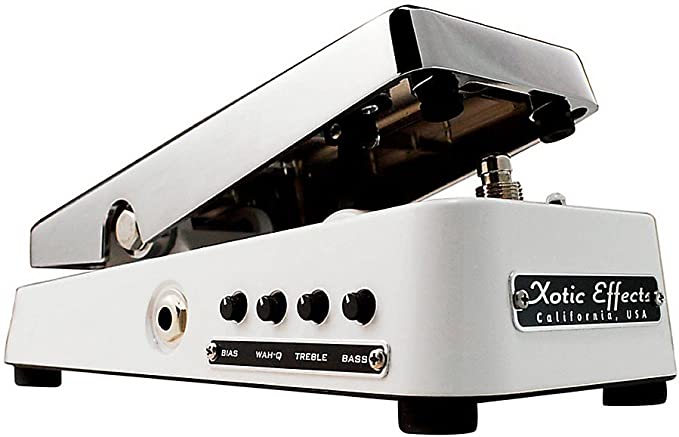
Named after the coveted ‘Holy Grail’ wah pedals from the late 1960s, the Xotic Effects XW-1 Wah Pedal is more than just a replica.
This silver, stompbox-style guitar effects pedal offers an array of unique features that bring versatility and tweakability to your fingertips.
Its dimensions are 9.75 x 4.4 x 3.4 inches and it weighs 2.4 pounds, making it a compact addition to any pedalboard.
One of its key features is the Bias Control, which lets you shape your sound as you please.
Coupled with the Wah Q Control, it provides a wide range of tonal possibilities.
This is further enhanced by its Treble and Bass Control, providing an extended frequency response.
A unique aspect of this pedal is the Adjustable Pedal Torsion, offering a customizable feel to the pedal’s action.
And, to keep you informed about the pedal’s status, it comes with an LED Indicator.
This guitar effects pedal truly places sound shaping in the hands of the player.
- My Review
When I first laid hands on the Xotic Effects XW-1 Wah Pedal, it was like picking up a legendary weapon in a game.
It’s compact, solidly built, and sporting a sleek silver finish, an aesthetic that implies a marriage of modern technology and vintage charm.
On stage, this thing is a rockstar; plug it in, and it’s ready to wail.
Now, the sound quality, ah! There’s the crux of the matter.
Echoing the revered tones of the ’67-’68 Italian Clyde McCoy Wahs, this pedal infuses your riffs with that elusive ’60s character.
But it’s more than a one-trick pony. The bias control and the wah Q control truly set this wah pedal apart.
I was amazed at how these features opened up an entire galaxy of tonal possibilities.
From subtly vintage to blisteringly modern, it was like having a sonic time machine at the tip of my toes.
Treble and bass control? Yes, please!
This pedal took the precision of my sound sculpting to a whole new level.
A noticeable lack of bass loss across the sweep range made my playing experience more satisfying.
In addition, I was impressed by how the pedal’s response remained consistently top-notch throughout the sweep, regardless of the settings I used.
Yet, like every hero’s weapon, it had its quirks. For example, an LED indicator sits there to tell me if the pedal’s engaged, but my foot often obscures it.
And though I appreciated the adjustable pedal torsion, I found the pedal’s tendency to drift back to its default position somewhat irksome.
But, minor gripes aside, the Xotic Effects XW overall is a fine piece of musical artillery.
Here are the ratings I’ll give to the Xotic Effects XW-1 Wah Pedal:
Its construction’s sturdiness, tonal versatility, and artistic control make it a worthy contender in the arena of guitar effects pedals.
But it isn’t just a pedal, it’s a tool that expands the musical imagination, and boy, does it play its part well!
- Pros:
- Wide range of tones
- Versatile and customizable
- Compact size
- Responsive and smooth wah effect
- Adjustable controls for fine-tuning
- Cons:
- Possible loud popping sound
- Temporary silence during wah activation
- Potential for defective units
My final verdict is that the Xotic Effects Wah XW-1 Guitar Effects Pedal is excellent for guitarists seeking a versatile and high-quality Wah pedal.
With its wide range of tones, customizable features, and smooth performance, it delivers on its promises.
The brand, Xotic Effects, is known for producing quality pedals, and while the pedal may come at a higher price point, its value is justified by its functionality and sound quality.
However, it is worth considering the potential issues, such as the possibility of a loud popping sound or temporary silence during activation.
If you’re looking for a versatile Wah pedal with great tone and performance, the Xotic Effects Wah XW-1 is highly recommended.
Behringer Hellbabe HB01 Wah-Wah Pedal
Optical control, customizable, no-nonsense build quality.
The HELL-BABE HB01 offers a variety of tone-sculpting options from old-school wah to modern sounds, plus adjustable frequency range, boost, and filter shaping. It features no-nonsense build quality with optical control and a spring-back pedal mechanism.
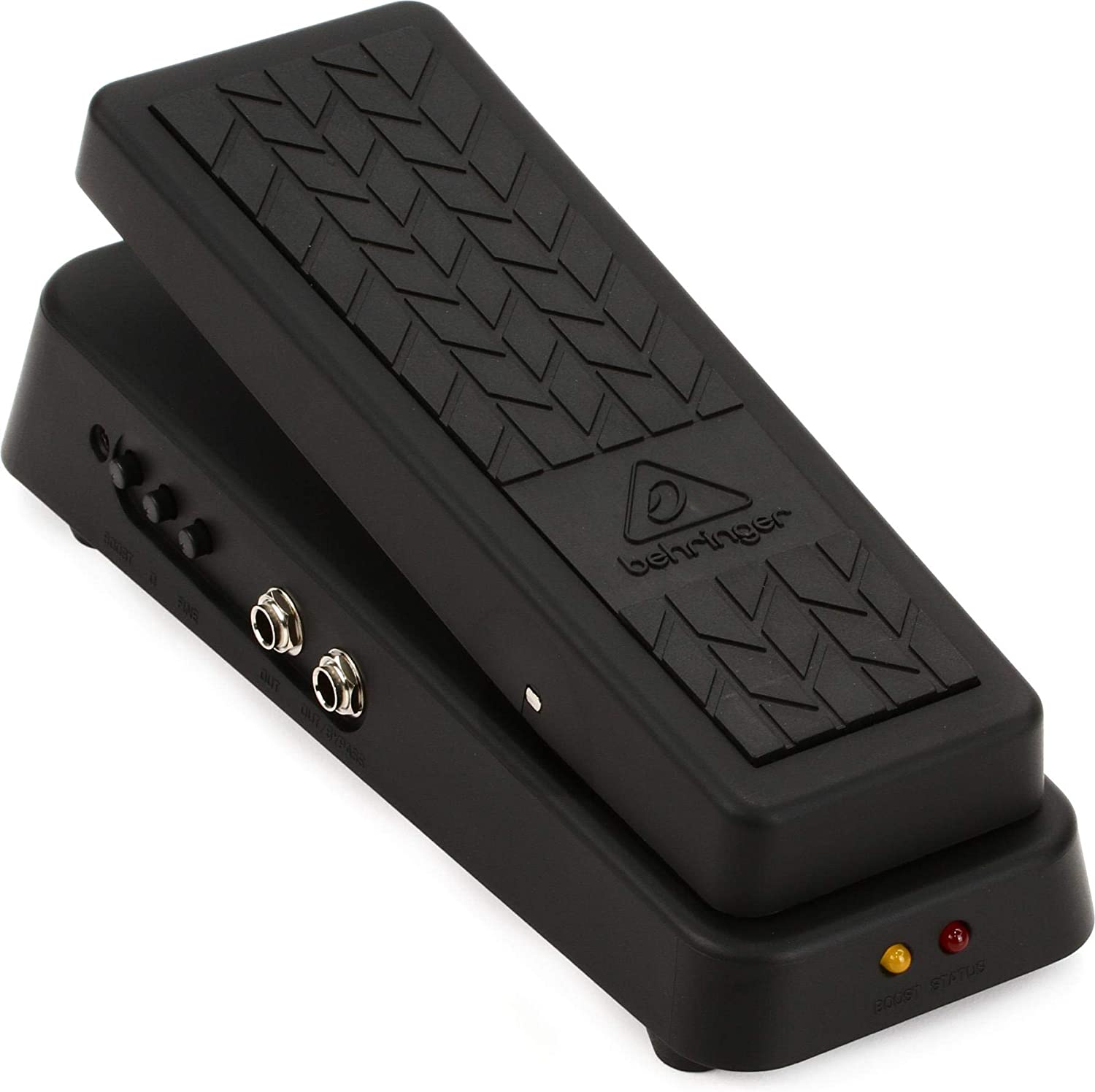
This little beauty, the Behringer Hellbabe HB01, is a versatile piece of equipment, ready to add depth and character to your guitar sounds.
As a wah-wah pedal, it provides that funky resonance many guitarists crave, bending your notes and harmonics in delightful ways.
But it’s not all about wah effects.
This pedal stands out for its tailor-made sound possibilities.
It comes with a unique spring-back pedal mechanism and an adjustable heel-down frequency range, allowing you to customize the pedal’s response to your foot pressure.
Additionally, an integrated fine-tune control ensures your sound is just right.
For further customization, the optical control feature means no mechanical potentiometer to wear out.
It also boasts ultra-low noise circuitry for quiet operation.
You’ll appreciate its rugged construction, designed to withstand the rigors of gigging while maintaining a sleek, aesthetic appeal.
Its dual LED indicators make operation a breeze, even in low-light situations.
- My Review
A sense of excitement washed over me when I plugged in the Behringer Hellbabe HB01.
This isn’t just a pedal; it’s a sonic chameleon that could spice up any guitar soundscape.
Let’s start with the build.
It’s a robust machine, built like a tank to endure the high-energy demands of live performances.
You won’t be tiptoeing around this one.
Its sturdy construction, while impressive, doesn’t compromise on aesthetics.
Thanks to the dual LED indicators, it has an almost rockstar-like appeal, its sleekness radiating in low-light scenarios.
Regarding its purpose, the Hellbabe HB01 is a delight to experiment with.
Each push on the pedal uncovers a new layer of funky, resonant guitar tones.
It’s almost as if you’re guiding a tone conversation, with the guitar’s notes responding to the slightest change in pressure.
What caught my attention was the adjustable heel-down frequency range.
It’s a unique feature that gives you the power to personalize the pedal’s response.
As a result, you can fine-tune your sound to the nth degree.
And, don overall silent operation due to ultra-low noise circuitry is a real treat.
However, no product is without its quirks.
The spring-back pedal mechanism, while innovative, might not appeal to everyone.
Nevertheless, it’s a feature that requires getting used to, especially for those accustomed to traditional wah pedals.
Another point to note is the optical control.
From a durability standpoint, it’s fantastic, removing any worries about worn-out mechanical potentiometers.
But it might seem unnatural for those who prefer the good old mechanical touch.
Here are the ratings I’ll give to the Behringer Hellbabe HB01 Wah-Wah Pedal:
Despite these minor quirks, the Behringer Hellbabe HB01 is a compelling wah pedal that deserves a spot on your pedalboard.
It isn’t perfect, but its charm lies in the expansive sound possibilities it provides, wrapped in a ruggedly handsome package.
- Pros:
- Easy frequency adjustment.
- Spring-back pedal mechanism.
- Fine-tune control.
- No mechanical pots or switches.
- Cons:
- Limited pedal range.
- Volume boost may be ineffective.
- Potential hiss or noise when engaged.
- Plastic housing may not be durable.
My final verdict is that this product is highly recommended.
It offers excellent versatility, a wide range of features, great tone, impressive performance, a reputable brand, and good value for the price.
It is a solid choice for users looking for a reliable and high-quality product.
MXR MC404 CAE Dual Inductor Wah Pedal
Jim Dunlop CAE Dual Inductor Wah Wah for two distinct tones and low noise operation.
MXR produces effects pedals for guitar and bass, including distortion, overdrive, fuzz, envelope filter, reverse delay, and auto-wah. It also produces a line of stompboxes for synthesizers and other instruments. The company’s signature products include the M132 Super Comp, M133 Microamp, M134 Stereo Chorus, and M109S 6-Band Graphic EQ. All MXR pedals are made with high-quality components and feature true bypass switching for a clean signal when the pedal is not in use. MXR is a manufacturer of high-quality effects pedals for guitar, bass, and other instruments. They offer distortion, overdrive, fuzz, envelope filter, reverse delay, and auto-wah pedals, along with a range of signature products and true bypass switching.
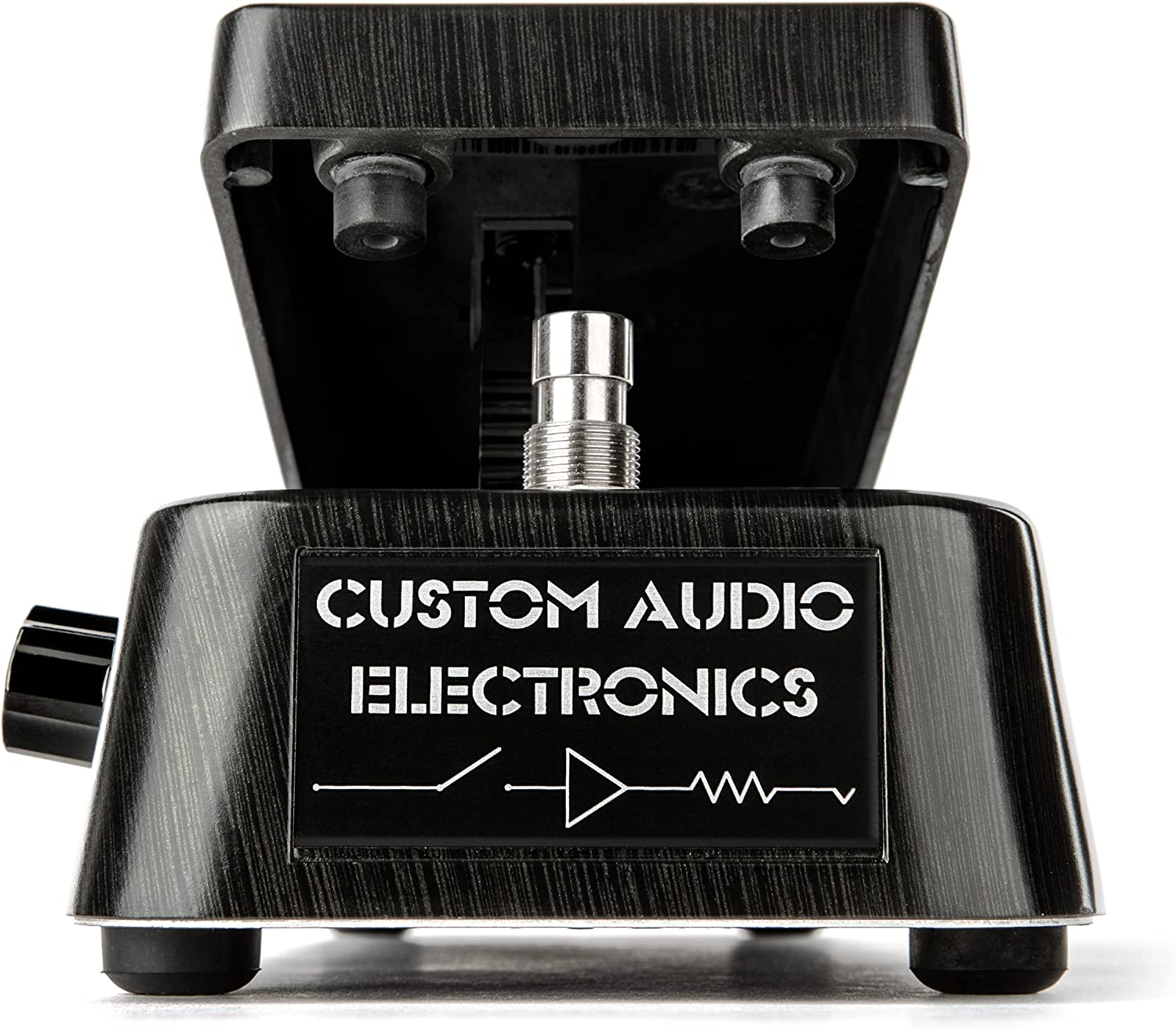
Designed by Bob Bradshaw of Custom Audio Electronics (CAE), this pedal is one-of-a-kind in the world of music gear.
Crafted for professionals and amateurs alike, it boasts two different inductors: the yellow Fasel inductor, famous for its sweet, singing tone, and the red Fasel inductor, known for its rich, throaty sound.
To enhance its sonic capabilities further, it’s equipped with an internal MXR MC401 Boost/LineDriver, a potent tool to enhance your tone.
With this, you have full control over output and gain levels, making you precisely shape your sound.
Let’s not forget the true built-in bypass, a feature crucial to maintain the integrity of your signal path when the pedal is disengaged.
Made with sturdy components and a durable casing, this pedal ensures longevity and solid performance, gig after gig.
It’s a truly impressive piece of kit!
- My Review
When I stepped on the MXR MC404 CAE Dual Inductor Wah Pedal, I knew it was a game-changer.
Not only does it scream quality, but its versatility is unparalleled.
Let me start with the dual inductors.
Each has its unique flavor, making this pedal like having two wahs in one box.
The yellow Fasel inductor brings a velvety, lyrical quality to the wah effect, while the red inductor adds a thick, rich texture.
Switching between them is as easy as flipping a switch, bringing an extra level of creative freedom to performances.
What knocked my socks off was the built-in MXR MC401 Boost/LineDriver.
This feature’s like having a shot of espresso for your tone.
Crank it up and watch as your sound jumps out of the mix, full of life and vitality. But be warned – it’s addictive.
Once you start playing with the boost, it’s hard to imagine your sound without it.
As for the true bypass, it’s a music-maker’s dream.
We’ve all had that heart-sinking moment when you disengage a pedal, only to hear your tone sputter and die. Not so with the MC404.
Even when it’s off, your sound’s integrity remains pristine, so your tone stays consistent, no matter how many pedals you add to your signal chain.
And lastly, there’s the build quality.
Solid as a rock and built to withstand the rigors of the road.
I do no doubt that this pedal will stand up to even the toughest gig conditions.
However, there’s always room for improvement.
The one area where the MC404 falls short is its lack of LED indicators to show which inductor is in use.
A minor quibble but an oversight that could confuse a high-pressure performance.
Here are the ratings I’ll give to the MXR MC404 CAE Dual Inductor Wah Pedal:
The MXR MC404 CAE Dual Inductor Wah Pedal is a fantastic addition to any pedalboard, offering exceptional versatility and performance.
It’s a pedal that pushes boundaries and refuses to play it safe.
- Pros:
- Two distinct tones with selectable inductors.
- Custom designed low noise potentiometer.
- User-selectable gain output stage with LED indicator.
- Low noise Class ‘A’ Operational amplifiers.
- Bright LEDs indicate effect status and boost mode.
- Cons:
- Noisy boost function for some users.
- Lack of on/off switch, requiring unplugging.
- No included manual to explain features.
- Possible issues with factory setup and stiffness.
- Sensitivity to position of range gain pot.
My final verdict is that the Jim Dunlop CAE Dual Inductor Wah Wah is a highly capable and versatile wah pedal with many useful features.
It offers two distinct tones with selectable inductors, a customizable gain output stage, and low noise operation.
The pedal performs well and is well-regarded by many users.
However, some reported issues include a noisy boost function and the lack of an on/off switch.
Despite these drawbacks, considering its solid build quality, brand reputation, and overall value for the price, the Jim Dunlop CAE Dual Inductor Wah Wah receives a positive verdict.
Fender Tread-Light Wah Pedal
Bright, adjustable tone with switchable LED and buffer.
Fender’s Tread-Light Wah Pedal offers adjustable treble, 3-way mid-frequency toggle, and switchable buffers for a versatile sound. It’s crafted from lightweight, durable anodized aluminum, with an under-treadle LED light and 9V DC power for ease of use on stage.
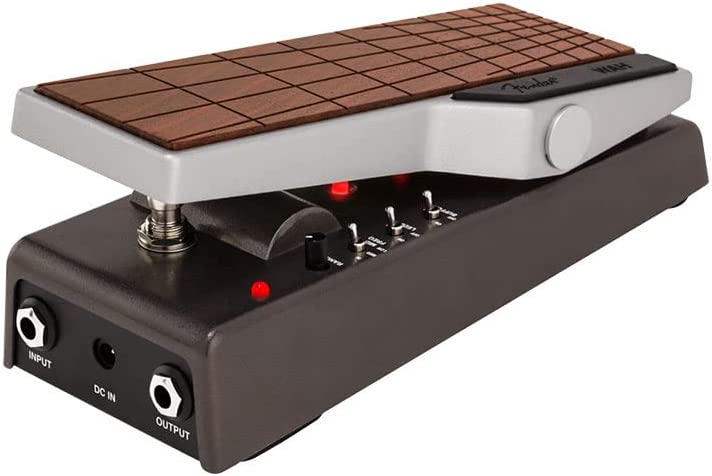
With the Fender Tread-Light Wah Pedal, you can experience the beauty of analog sound.
This compact yet durable device comes with a 3-Way frequency selector, allowing you to fine-tune the range to your liking.
Should you prefer a more classic wah sound or something buffered, an internal switch lets you flip between the two.
Adding a touch of functionality, the under-treadle LED is controllable via a toggle switch.
This can be a lifesaver on dimly lit stages, ensuring you always know where the pedal is.
A standard 9V DC connection, a common format for most pedalboards and power supplies, powers the pedal.
Constructed from lightweight, anodized aluminum, the Tread-Light Wah Pedal doesn’t compromise durability.
In addition, its distinctive woodgrain treadle gives it an added flair of style.
This Fender product packs a punch despite being slightly smaller than you might expect.
With its dimensions of 9.25 x 3.75 x 2.75 inches, and a weight of 839 grams, it’s designed for convenience and portability.
- My Review
Slipping my foot onto the Fender Tread-Light Wah Pedal, I couldn’t help but appreciate the craftsmanship.
Its blend of anodized aluminum and woodgrain treadle was a pleasant departure from your average pedal design, proving that even the smallest details can make a big difference.
Moreover, as compact as it is, the pedal doesn’t skimp on delivering a powerful performance.
Diving into the analog soundscape, the 3-Way frequency selector was a charm.
This little dial provides great control over the wah’s cry, allowing me to dial in on the sound I wanted easily.
The switchable internal buffer was another pleasant surprise.
Flipping between a classic and buffered wah added versatility to my sound.
However, a slight hiccup was noticeable.
While a thoughtful addition for dark stages, the under-treadle LED lights seemed less bright than expected.
A faint interference noise popped up when the lights were on, which could be a drawback if you’re particular about maintaining pristine audio.
The pedal’s stage-ready construction is unquestionably sturdy, but I did sense a bit of fragility under rigorous use.
It did well during live performances, yet I was cautious not to push it too hard.
While it didn’t affect the overall functionality, it might be something to remember if you’re an aggressive pedal stomper.
That said, the Tread-Light Wah Pedal was an enjoyable experience.
It offers more than just a stylish exterior; it has enough tweakable options to suit various tastes.
Here are the ratings I’ll give to the Fender Tread-Light Wah Pedal:
Even though it might not have the grit of a traditional crybaby, it holds its own with a unique blend of design and functionality.
Of course, it’s not perfect, but what truly is?
- Pros:
- Stylish design
- Adjustable frequency and range
- Switchable buffer
- Under-treadle LED light
- Stage-ready construction
- Cons:
- Not the warmest sounding wah
- LEDs may cause interference noise
- Some reviewers found it weak
- Possible build quality issues
- Potential switch reliability concerns
My final verdict is that the Fender Tread-Light Wah Pedal is a solid choice for guitarists looking for a versatile wah pedal with adjustable frequency and range.
It offers a stylish design, switchable buffer, and under-treadle LED light.
However, it may not deliver the warmest wah tone, and some reviewers have raised concerns about potential build quality issues and switch reliability.
Considering its brand reputation, features, and overall value, it remains a reliable option for many guitarists.
Hotone Soul Press Mini Wah Pedal
Compact 3-in-1 pedal with Wah, Volume, and Expression modes.
The Hotone Soul Press is a multi-functional mini pedal providing Wah, Volume, and Expression modes for convenience and flexibility. It features a classic Cry Baby tone and an active circuit that keeps your sound lossless. The unit includes a Bottom Value control for precision, True Bypass circuitry, and a 9V battery compartment.
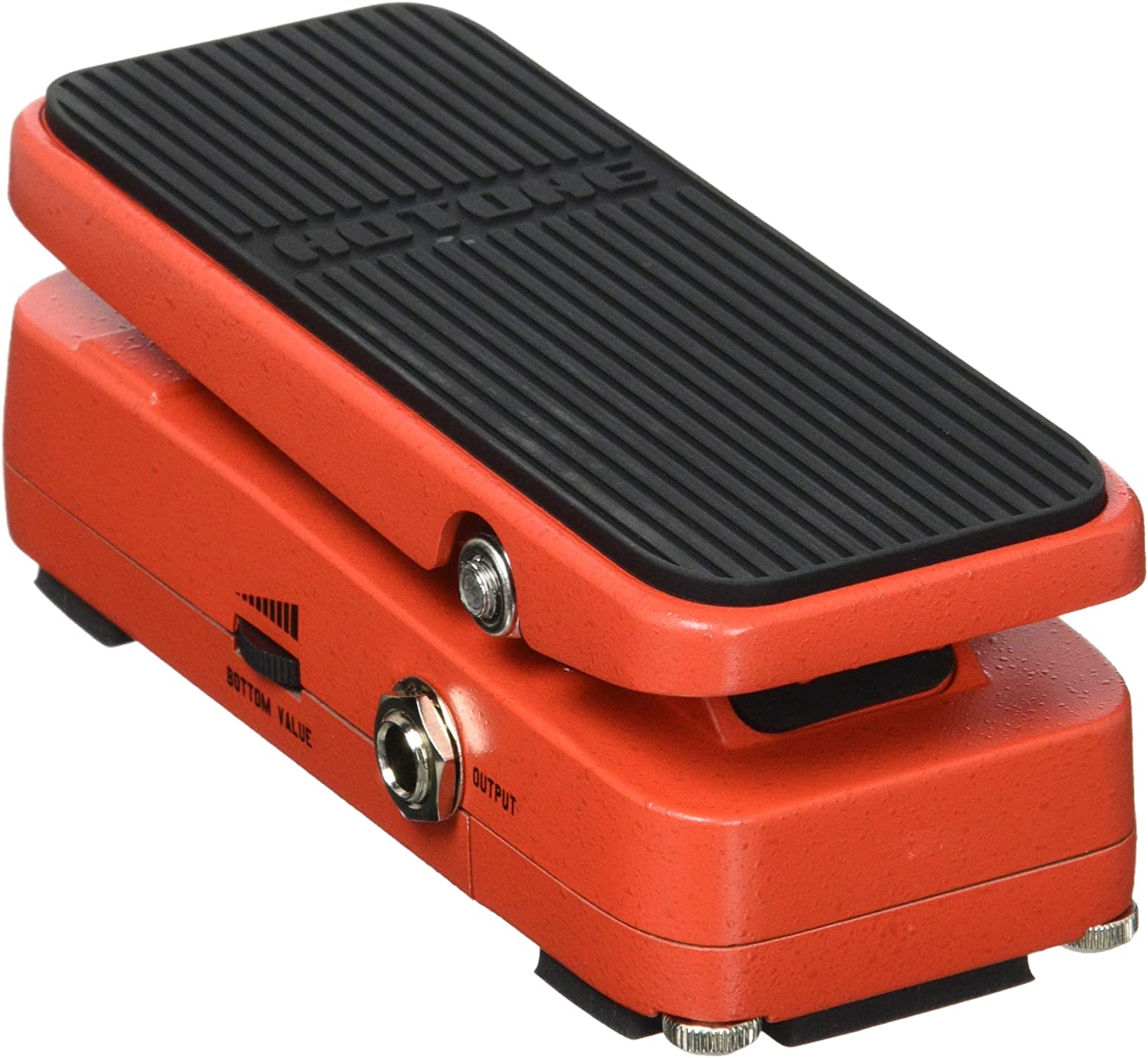
The Hotone Soul Press Pedal is a 3-in-1 device with the functionalities of a volume, wah, and expression pedal packed into a compact yet sturdy design.
Borrowing its sound from the iconic crybaby wah pedal, it’s designed to deliver lush harmonics and a wide vocal range.
In addition to that, an adjustable control range allows for tailored use.
And its true bypass feature ensures a pure signal in and out.
Active volume mode is another nifty feature.
It’s engineered to maintain your sound’s integrity, ensuring your tone is lossless.
Besides, you can set your preferred lower limit volume for more precise control.
Last but not least, let’s not forget the cool LED lights that give it a funky aesthetic and lightweight design.
As a result, the Soul Press Pedal is a versatile and practical addition to any musician’s toolkit.
- My Review
Putting my hands on the Hotone Soul Press Mini Wah Pedal, I was immediately struck by its compact yet durable design.
As they say, it’s small but mighty, the perfect sidekick for a pedalboard already teeming with effects.
When I stepped on the wah feature, I felt like I was able to draw out a tone reminiscent of the classic crybaby wah, which isn’t a small feat for a pedal of this size.
The sweep was wide and expressive, bringing a new level of dynamism to my solos.
It’s as if my guitar had suddenly found a new voice, rich in nuances.
Switching to volume mode, I admired the smooth taper that maintained the integrity of my tone, even at the lowest settings.
Adjusting the minimum volume limit was a nice touch, allowing for more granular control.
As an expression pedal, I found it quite adaptable and compatible with various other pedals.
As a result, I had the opportunity to bend my sounds in intriguing ways, making my playing experience feel almost interactive.
I must point out, however, that with so many functionalities packed into such a tiny frame, getting the hang of the controls took a bit of time.
But once you get used to it, it’s as easy as pie.
But what’s functionality without aesthetics, right?
The blue LED lights add a stylish edge and are practical for darker stage setups.
Despite a slight learning curve, the Hotone Soul Press Mini Wah Pedal quickly proved to be an indispensable piece of kit.
Here are the ratings I’ll give to the Hotone Soul Press Mini Wah Pedal:
A 3-in-1 pedal that offers so much versatility while maintaining a top-notch sound quality and user-friendly operation is indeed a rare find.
It’s like a Swiss Army knife in the world of guitar pedals, ready to enhance your musical journey immediately.
- Pros:
- Compact size
- Multiple functionalities (Volume/Wah/Expression)
- Adjustable control range
- True bypass
- Good build quality
- Cons:
- Potential noise issues in clean wah mode
- Difficult access to wah pot for cleaning
- Susceptibility to crackling sounds in wah mode
- Switching between wah and volume requires manual adjustment
- Potential durability concerns
My final verdict is that the Hotone Soul Press 3 in-1 Mini Volume/Wah/Expression Effects Pedal is a versatile and feature-rich pedal with a compact size.
It offers adjustable control range, true bypass, and good build quality.
However, it may have noise issues in clean wah mode and access difficulties for pot cleaning.
In addition, while it has received positive reviews for its functionality and value, there have been reports of durability concerns and quality control issues.
It can be suitable for those seeking a compact multi-functional pedal, but it’s important to consider individual needs and preferences before purchasing.
Vox V847A Wah-Wah Pedal
Authentic VOX tone in a classic wah-wah pedal with AC power capability.
The VOX V847 Wah-Wah Pedal is a reissue of the classic 60’s model with AC power capability and a buffered input jack for preserving the unprocessed guitar tone. It is built to the exact specification of the original pedal and features an inductor redesign for improved dynamics and tone. Includes a vinyl carry bag. Battery and optional AC adapter required for operation.
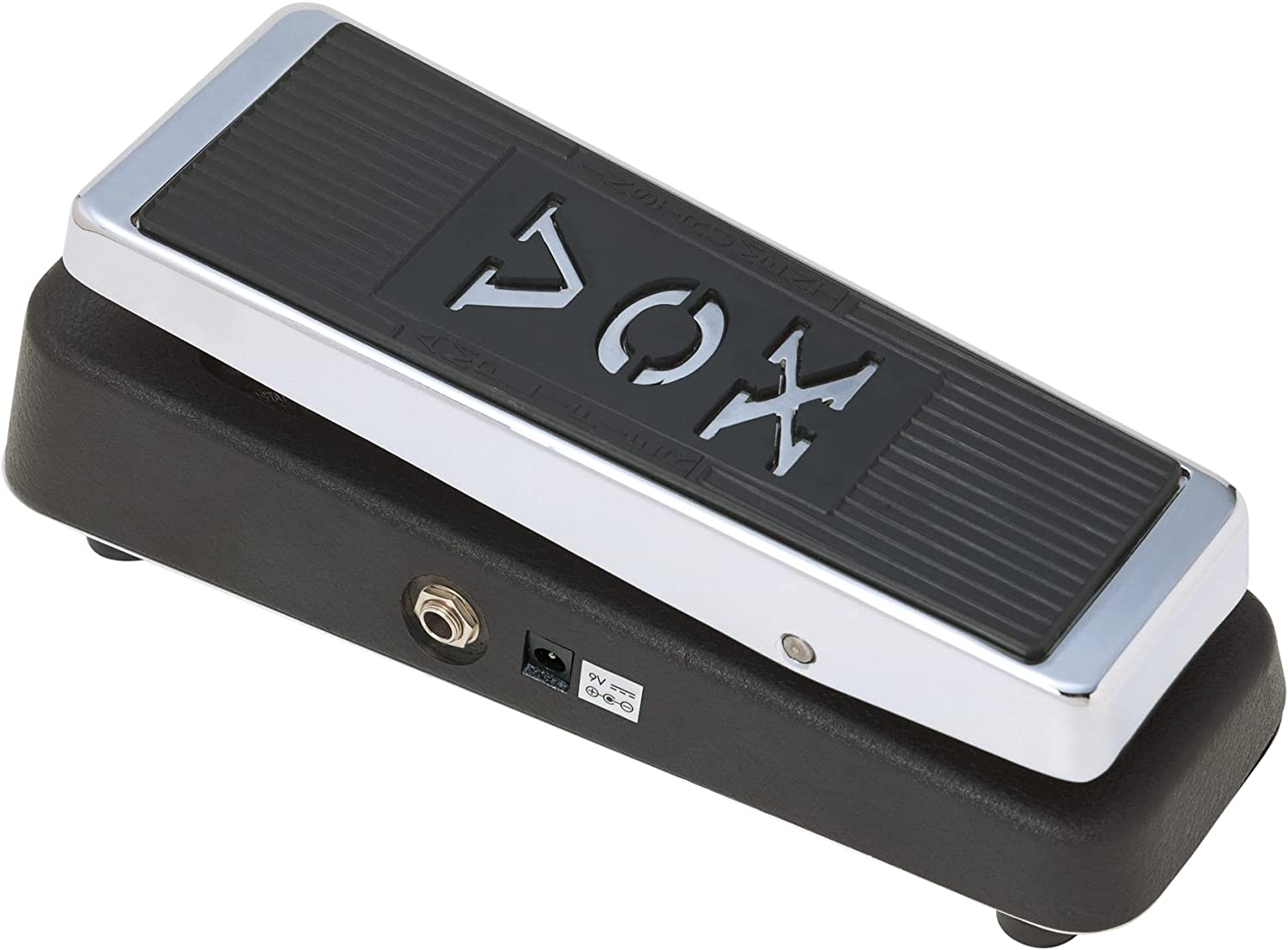
Unleashing your inner Hendrix might be easier with tools like Vox’s V847A Wah-Wah Pedal.
This reimagines the iconic 1960s original, boasting an authentic vintage design.
Musicians can easily sculpt their sound with a wide dynamic range thanks to the pedal’s impressive response.
Regarding resilience, the solid construction of the V847A speaks volumes, making it a great choice for studio recording and live performances.
One of the stand-out features is the buffered input jack, preventing impedance issues that can hamper your sound quality.
Another highlight is the easy-to-use design, with a single on/off switch contributing to the pedal’s simplicity.
Don’t forget about the AC power capability, a reliable battery alternative.
Let’s not overlook the aesthetics – the V847A maintains the style of yesteryears with its distinctive black casing and silver top.
This pedal is a testament to Vox’s dedication to quality, giving musicians the tools to carve their unique sound.
Beyond its great features, the Vox V847A is known for its flexible tone-shaping capabilities.
Again, the potentiometer design plays a key role, using a 100k ohm Hot Potz potentiometer to create that classic, rich wah tone.
Couple this with a hefty inductor to emulate the magnetic core of the original, and you’ve got a pedal that truly captures the spirit of the 60s.
Even the true bypass wiring is a thoughtful touch, minimizing tonal loss while delivering pure and transparent sound.
From a more technical perspective, the pedal operates within a 100Hz–5.6 kHz frequency range, allowing you to shape your tone across a broad spectrum.
- My Review
Having played around with the Vox V847A Wah-Wah Pedal, I must say this thing is a joy.
It’s like stepping back in time, immersing myself in the iconic sounds of the 60s.
That distinctive ‘wah’ is rich and capable of delivering an incredibly broad range of sounds.
Let’s say the tonal possibilities left me grinning like a kid in a candy store.
Sure, it’s a simple pedal, lacking some advanced features in modern counterparts.
But this simplicity is part of its charm, a no-nonsense piece of gear that speaks to a bygone rock and roll era.
First, however, let’s not forget about the true bypass design.
In my opinion, it’s a masterstroke, preserving the integrity of the signal chain when the pedal is disengaged.
Regarding construction, this pedal is built like a tank, ready to withstand any gigging misadventures.
Yet, despite this robustness, it’s surprisingly light on the foot, making it easy to manipulate on the fly.
I did find one thing to nitpick, though.
Given the vintage charm of this pedal, it’s a tad disappointing that it doesn’t run on a 9V battery alone; you’ll need an AC adapter for those longer sessions.
Not a deal-break overall, but a minor inconvenience nonetheless.
I was impressed by the potentiometer design too.
It’s like the magic wand in this pedal’s arsenal, helping you craft that perfect wah tone.
The inclusion of a hefty inductor also wins my approval, as it helps emulate the magnetic core of the original.
Here are the ratings I’ll give to the Vox V847A Wah-Wah Pedal:
So, if you ask me, the Vox V847A Wah-Wah Pedal is more than a piece of equipment—it’s a time machine, whisking you back to an era where the ‘wah’ was king.
You might find a few minor inconveniences, but overall, it’s worth every penny for that authentic, vintage tone.
- Pros:
- Easy fix for rubber limiters.
- Great vintage tone.
- Reasonable price and good reviews.
- Authentic sound with period-correct design.
- Sturdy and simple to use.
- Cons:
- Thin and harsh sound for some.
- Limited range for certain users.
- Switch durability issues reported.
- No tactile feedback on the footswitch.
- Not suitable for modern music styles.
My final verdict is that the VOX V847A Wah Wah Guitar Effects Pedal, Black is a solid choice for guitarists seeking a classic Wah sound with an authentic design.
It offers versatility and features, delivering a vintage tone and satisfactory performance.
The brand reputation of VOX adds to its appeal, and considering its reasonable price, it provides excellent value for money.
However, some users may find it sounds thin or limited in range, and issues with switch durability have been reported.
Overall, it is a worthwhile option for those seeking a reliable wah pedal.
SONICAKE Active Volume & Wah Expression Pedal
Compact, versatile, and affordable, SONICAKE VolWah Active Volume & Wah Pedal.
SONICAKE VolWah Pedal combines an active volume and a vintage wah in a mini-sized pedal, perfect for players who want a space-saving and convenient solution. The circuit design offers a dynamic and responsive sound, making it great for all genres of music. LED lights indicate which mode the pedal is in and the hard plastic casing is lightweight yet robust.
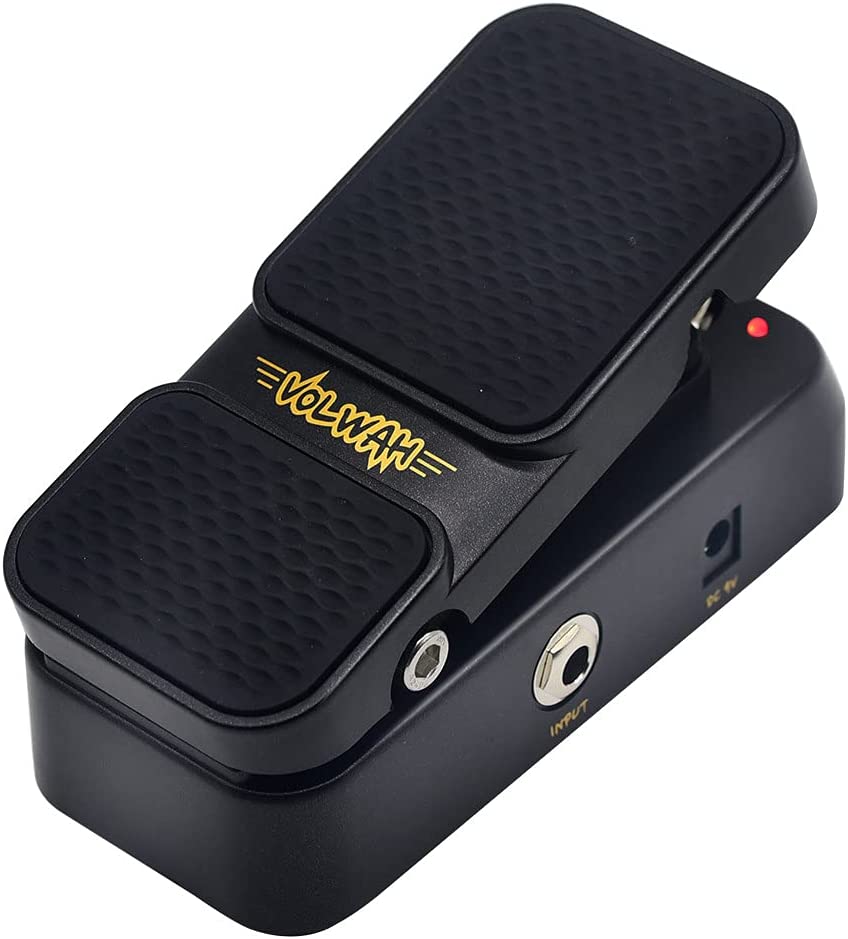
SONICAKE’s Active Volume and Wah Pedal, the VolWah, is a versatile tool for any guitarist.
Despite its lightweight build, its analog design fits both volume and wah effects into a compact unit that’s surprisingly sturdy.
The active volume control element efficiently reduces impedance mismatch issues, ensuring smooth signal flow.
It also allows for easy switching between volume and wah modes with the help of an inconspicuous footswitch.
This pedal’s look is striking, dressed in sleek black, and built with space-saving dimensions, making it a handy addition to your pedal board.
Apart from its compact size and dual functionality, it has two illuminating LED lights that help you keep track of your operating mode – a useful feature when you’re engrossed in playing.
Note that this pedal requires a power adapter, which isn’t included in the package.
- My Review
What a ride it’s been, putting the SONICAKE Active Volume and Wah Pedal, the VolWah, through its paces!
Let me share some of the highs and lows.
First off, this pedal’s slim form factor is a breath of fresh air.
Tucked neatly into any pedalboard, it’s like that quiet workhorse in the corner, diligently doing its job without stealing the limelight.
Upon plugging it in, the immediate standout was the volume control.
It showed consistency and finesse, much like a smooth operator in a well-oiled machine.
Its active design obliterated impedance mismatch issues, like a samurai sword cutting through silk.
Moreover, the transition between volume and wah mode was as seamless as possible, a swift toe-tap and voila!
But it wasn’t all sunshine and rainbows. The power adapter not being part of the package was a letdown.
Imagine waiting for a delicious cake, only to find the cherry on top missing. It’s a small detail, but it counts, right?
Switching to the wah effect, it was a journey back in time.
The vintage-inspired sound could almost make one see the smoke-filled rooms and hear the jam sessions of the classic rock era.
However, it might not be everyone’s cup of tea, especially if you’re into a more modern wah tone.
A handy feature was the illuminating LED lights.
Picture it like a friendly guide in the darkness, signaling whether you’re in volume or wah mode.
So even when lost in the euphoria of a killer riff, the VolWah had my back.
Here are the ratings I’ll give to the SONICAKE Active Volume & Wah Expression Pedal:
The VolWah may not be a flawless gem, but it shines brightly in its own right.
Moreover, it’s a worthy ally, blending functionality, style, and a dash of nostalgia in one compact package.
- Pros:
- Compact size
- Switches between wah and volume
- Good wah sound
- Reasonable price
- LED lights indicate mode
- Cons:
- Some durability issues
- Possible noise and static
- Small size may be difficult for larger feet
- Limited visibility of LED lights
My final verdict is that the SONICAKE VolWah Active Volume & Wah Pedal is a compact and reasonably priced pedal with some useful features.
It offers versatility with its ability to switch between wah and volume modes.
The pedal has received positive reviews for its good wah sound and the convenience of LED lights indicating the mode.
However, it has some drawbacks, including potential durability issues, possible noise and static, and limited LED light visibility.
Considering its price and features, this compact wah and volume pedal may be a good choice for those seeking such a product.
MORLEY 20/20 Bad Horsie Wah Guitar Effects Pedal
Legendary Bad Horsie Wah with switchless operation and premium buffer.
Morley’s Bad Horsie Wah pedal offers switchless activation, dual Wah modes with tone and level control, plus a buffer circuit for protection and LED indication. It’s spring loaded switchless activation ensures it will always be off when you step off, and the glow-in-the-dark details make it easy to find on a dark stage. Perfect for those looking to get a classic sound with modern convenience.
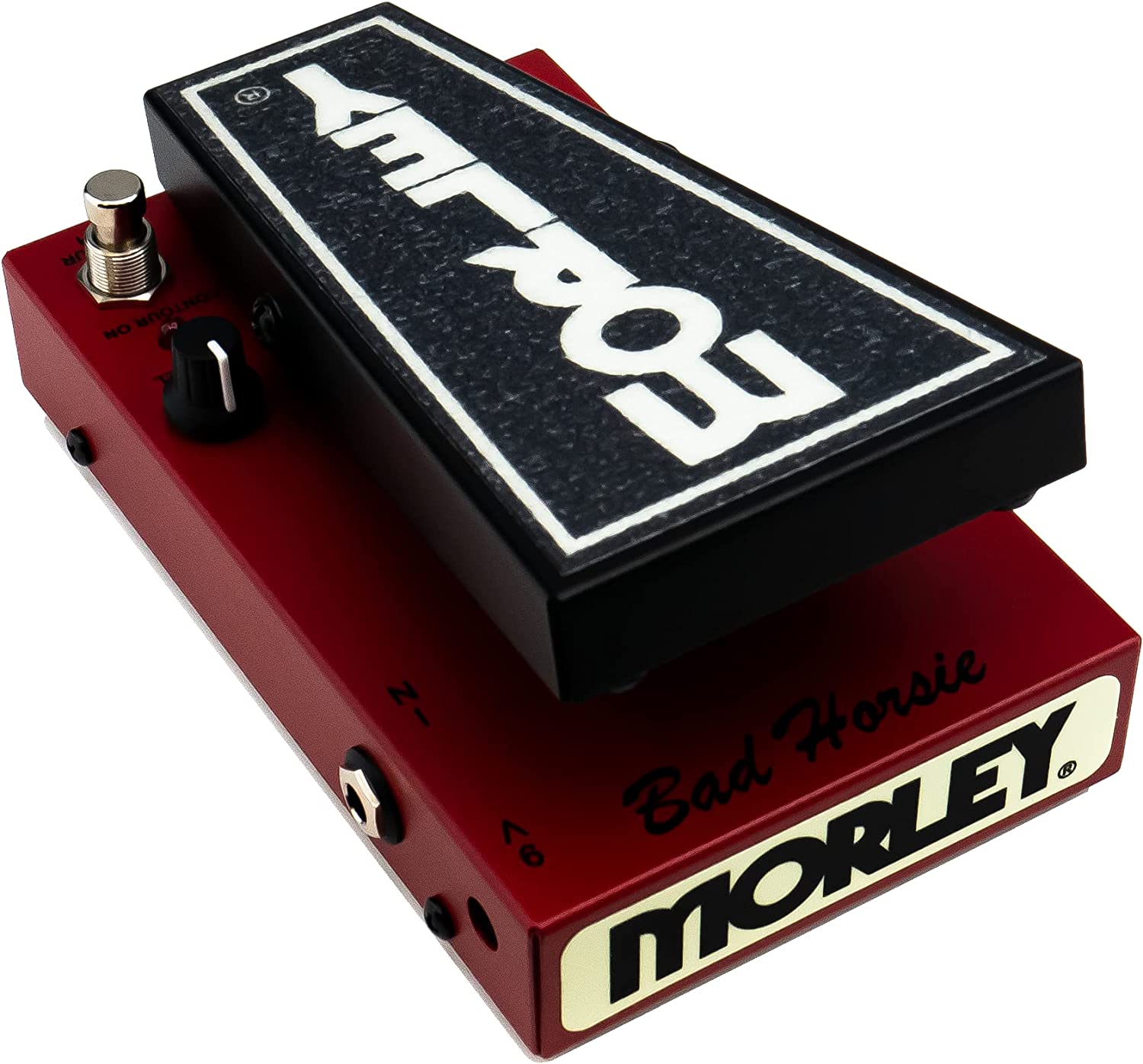
Built to last with robust construction, the Red MORLEY 20/20 Bad Horsie Wah is a celebrated guitar effects pedal, now in a compact form that easily fits on your pedalboard.
At the heart of its design is a switchless operation that makes it seamless to use: step on to engage and step off to bypass.
This feature ensures that mechanical failures or awkward foot switches won’t interrupt your performance.
Coupled with a premium Morley buffer, your guitar tone stays protected and pristine.
This American-made product has two modes: standard and contour modes, which lets you alter the tone you like.
The pedal boasts an impressive 15 dB level control, ensuring your sound isn’t lost in the mix.
Moreover, its glow-in-the-dark treadle rubber and LED indication make it easy to find on a dimly lit stage.
As an added advantage, its optical circuitry offers durability and consistent performance, unlike traditional potentiometers prone to wear.
- My Review
When I first saw the MORLEY 20/20 Bad Horsie Wah Pedal, its vibrant red hue seemed to beckon to me, promising a blend of form and function.
It’s like a sports car in the world of guitar pedals, standing out in its sleek and compact size that whispers, rather than shouts, “pedalboard-friendly.”
Slipping my foot onto this pedal was like stepping into a conversation with an old friend.
Its switchless operation is indeed an innovative approach that streamlines the user experience.
You step on to activate it, then off to bypass.
There are no awkward foot switches or interruptions – it’s pure, uninterrupted music.
With two modes on board – Standard and Contour, the Bad Horsie allows you to alter your tone on the fly.
This feature, akin to a Swiss Army knife in versatility, ensures that your sound can adapt to different musical contexts.
While the pedal proved responsive and smooth, I found the optical circuitry commendable.
It promises longevity and consistent performance as a trusty steed that refuses to buckle under pressure.
Traditional potentiometers tend to wear down over time, but with optical circuitry, that concern becomes a thing of the past.
On a dimly lit stage, the glow-in-the-dark treadle rubber was a spotlight in the gloom.
It’s a small but essential detail, like finding your way home in the dark. Yet, perfection is elusive.
While the contour and level knobs allow for a fair degree of tone and volume control, their proximity to the foot pedal can be a bit challenging.
A swift, unintended knock could potentially alter your settings mid-performance.
Plus, the absence of a power adapter was a noticeable oversight for a product at this price point.
Here are the ratings I’ll give to the MORLEY 20/20 Bad Horsie Wah Guitar Effects Pedal:
The MORLEY 20/20 Bad Horsie symphony has soaring highs and a few poignant minor chords.
But then again, isn’t it the blend of all notes that makes music so captivating?
- Pros:
- Easy and convenient switchless operation.
- Two wah modes with tone control.
- Pedalboard-friendly size.
- Premium Morley buffer for tone protection.
- Optical circuitry for durability.
- Cons:
- Click sound during switching.
- Possible issues with automatic turn off and default heel-down sound.
- Dials positioned close to the foot pedal.
- No power adapter included.
- Small pedal size may cause accidental knob adjustments.
My final verdict is that the MORLEY 20/20 Bad Horsie Wah Guitar Effects Pedal is a highly versatile and feature-rich with excellent tone and performance.
The Morley brand’s reputation for quality shines through, and while it offers great value, there are a few minor drawbacks to consider.
Guitarists who value a wah pedal that is both dependable and expressive will find it to be a fantastic option.
JIM DUNLOP Justin Chancellor Cry Baby Wah
Customizable, vintage fuzz and wah sounds with easy installation.
The Justin Chancellor Cry Baby Wah is a multi-effect pedal combining a custom midrange filter, wah circuit, and vintage fuzz. It’s perfect for bassists who want to explore soundscapes and push sonic boundaries with their instrument. With separate Volume and Q controls, two voices, and a built-in fuzz, this pedal is a must-have for tone-crafting bassists.
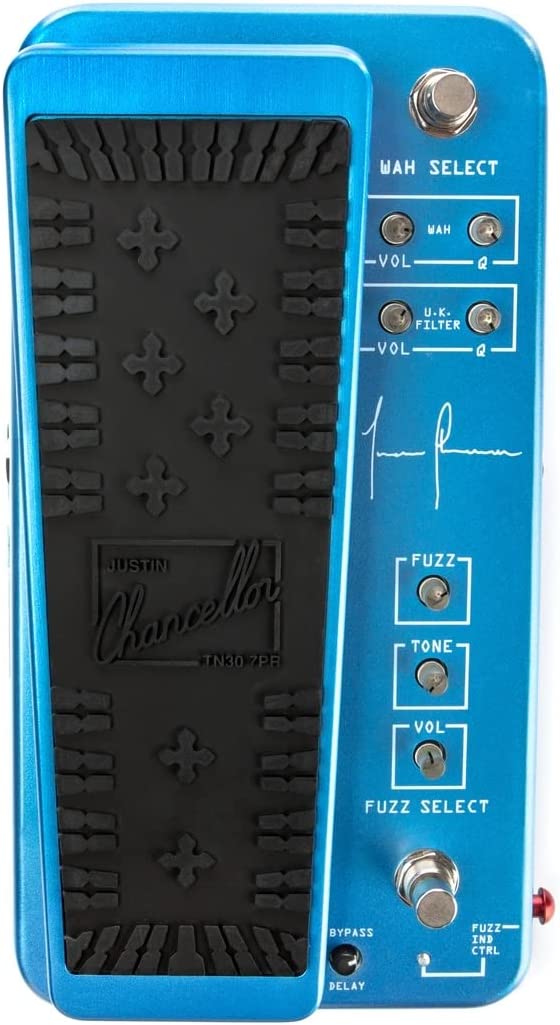
This unique bass effect device is called the Justin Chancellor Cry Baby Wah, crafted by Jim Dunlop.
The most intriguing aspect of this instrument accessory is that it merges three distinctive sounds into one pedal – a custom midrange filter, an assertive wah circuit, and a vintage fuzz effect.
In addition, the design is directly influenced by Justin Chancellor’s iconic bass tone and style.
With a solid blue exterior and an impressive list of features, it aims to emulate the unique tones and textures of the bass player from the band, Tool.
You’ll discover two distinct sound modes: a U.K. Filter replicating Justin’s bass’s throaty, voice-like phrasing and a modified Cry Baby Wah that delivers a bright, rich sound.
There’s also an integrated vintage fuzz feature, providing a gritty texture to your bass lines.
Plus, it has separate volume Q controls for customization and a U.K.-style fuzz that can operate alongside either mode or independently.
This pedal was crafted not just for regular bass playing but for those who want to explore the vast palette of sonic possibilities.
With an included pedal topper, you can easily switch between the different modes while playing, allowing you to shape your sound in real time.
This is undoubtedly a versatile tool for bass players experimenting with their sound.
- My Review
Navigating the sonic waters of the Justin Chancellor Cry Baby Wah by Jim Dunlop was akin to stepping into a treasure trove of bass tonal possibilities.
With its stylish blue chassis and heavy-duty construction, this pedal promises durability that goes hand in hand with its broad tonal range.
Initially, the pedal’s two primary modes—U.K. Filter and Cry Baby Wah—caught my attention.
The U.K. Filter mode provides a distinctive, throaty voice reminiscent of the Chancellor’s unique style.
It’s like diving into a sonic pool, its depths filled with rich, textured undertones.
On the other hand, the Cry Baby Wah mode is anything but subtle.
Its assertiveness slices through the air with bright, resonant harmonics that ripple out, causing an engaging sonic stir.
A compelling element was integrating the vintage fuzz feature, an asset that allowed me to add a gritty yet precise layer to my sound.
An element that harks back to the aggressive texture of classic rock tones.
It could produce a robust and satisfying growl, transforming my bass lines into something raw and visceral.
Adding to its allure, this device has separate Volume and Q controls, making it easy to customize my sound.
It was like having an audio chef’s knife, allowing me to precisely carve out my sonic space.
However, the pedal did have its quirks.
Though sonically pleasing, the fuzz function took a little while to engage, which was somewhat of a hiccup in an otherwise smooth performance.
But once fired up, it maintained a consistent performance, adding a delectable layer of fuzz to the mix.
Here are the ratings I’ll give to the JIM DUNLOP Justin Chancellor Cry Baby Wah:
Navigating the Dunlop Justin Chancellor Cry Baby Wah is indeed a musical adventure.
Its strengths lie in its versatility, robustness, and the sheer enjoyment of tweaking its various features to create engaging bass tones.
- Pros:
- Great sound quality
- Combines three effects into one pedal
- Customizable volume and Q controls
- Includes a vintage-style fuzz
- Solid build quality
- Cons:
- May require separate power adapter and cables
- Some negative reviews regarding functionality issues
- Relatively high price ($300)
My final verdict is that the JIM DUNLOP Justin Chancellor Cry Baby Wah, Blue (JCT95) is a highly versatile and feature-rich guitar effect device.
This pedal offers fantastic sound quality and a variety of wah tones, thanks to its ability to combine three effects in one and customizable controls.
Its vintage-style fuzz and the positive customer reviews make it a noteworthy option. Plus, the easy replacement for faulty units is a huge plus.
However, it’s important to remember that separate power adapters and cables may be necessary, and the price is relatively high.
It’s a reliable choice for musicians seeking a versatile, high-performance wah pedal.
Mooer Audio The Wahter Wah Pedal
Mooer Audio’s Wahter Wah delivers classic wah tone, with mini size, dual activation methods, and easy setup.
Wahter is a mini-sized wah pedal with classic wah tone and dual activation methods, providing a reliable and solid sound. It’s easy to set up with included instructions and is designed for durability for any playing style.
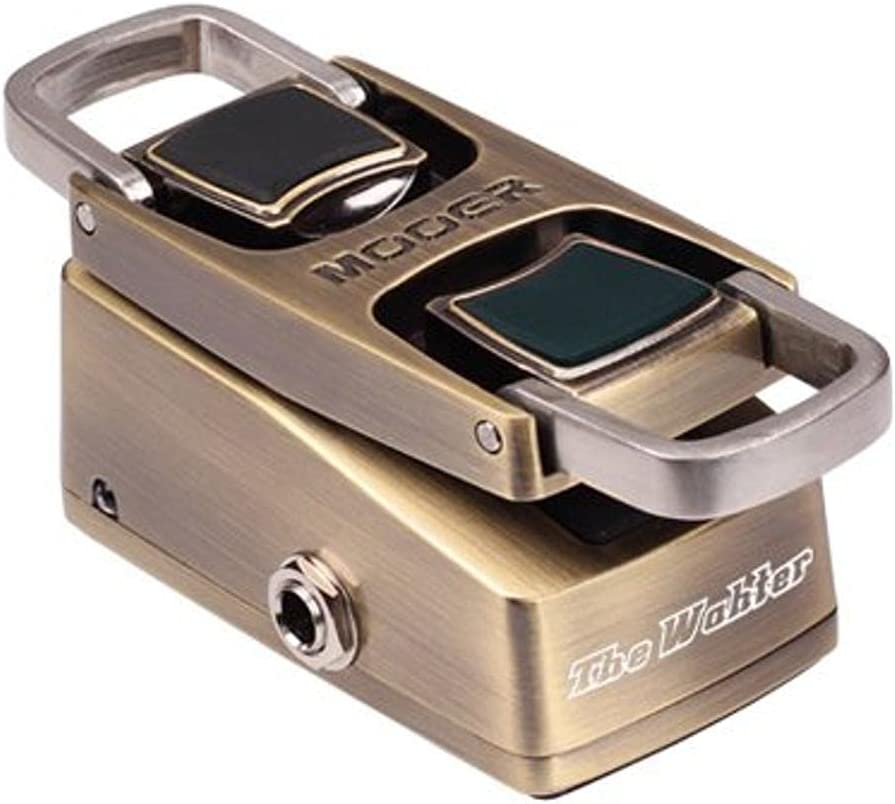
The Mooer Audio The Wahter is a dynamic, multi-functional wah effects pedal.
With its unique design and gold color, this mini pedal packs quite a punch despite its small size – just 3.7 x 2 x 1.7 inches and weighing only 0.16 kilograms.
Its ability to produce the iconic vocal sweep and lush harmonics akin to the classic wah tone sets it apart.
Housed in a sturdy metal casing, this device is built to last.
Another remarkable feature is its touch-sensitive activation.
It’s equipped with four pressure sensors, meaning you need to put your foot on the pedal to start playing, no stomping is required.
Also notable is its true bypass and an extendable pedal ring for better contact and enhanced sensitivity.
Do remember, though, it requires a 9V power supply to operate.
This innovative, compact piece of gear could be an interesting addition to your setup.
- My Review
Right out of the gate, let’s address the elephant in the room: the Mooer Audio The Wahter Wah Pedal is tiny.
Its small stature, however, doesn’t hold it back. Instead, it’s a testament to its incredible engineering.
Its compact size makes it a godsend for musicians wanting to save space on their pedalboard.
Weighing only 0.16 kilograms, it’s easy to move and secure. It’s like carrying around a little pocket of magic.
Despite its mini proportions, this pedal doesn’t skimp on sound quality.
The tone generated by this device beautifully mimics the classic wah effect, producing rich harmonics and sweeping vocal sounds that can make any guitar sound incredible.
It’s like your instrument has found its voice.
A standout feature, and one that gives it a futuristic touch, is its touch-sensitive activation.
Gone are the days of stomping; just a light press, and you’re playing.
Instead, four pressure sensors underfoot make this magic happen; let me tell you, it’s an absolute game-changer.
Let’s not forget its true bypass and extendable pedal ring, enhancing its sensitivity and performance.
In addition, the golden casing is aesthetically pleasing, robust, and solid, adding to its durability.
Now, it’s not all sunshine and roses.
Although this pedal impresses on many fronts, it does have a bit of a learning curve.
With its small size and different activation method, it takes some getting used to.
Plus, it needs a 9V power supply, which can inconvenience some.
So, is the Mooer Audio The Wahter a good buy?
It’s safe to say it’s a solid choice for those looking for a compact, unique wah pedal with impressive tonal quality.
Here are the ratings I’ll give to the Mooer Audio The Wahter Wah Pedal:
Just keep in mind that it might take a little time to find your footing with anything new.
But once you do, it’s like adding a dash of spice to your sonic recipe.
- Pros:
- Small and compact size
- Recreates classic wah tone
- Touch-sensitive on/off operation
- Extendable pedal ring for enhanced sensitivity
- Solid metal construction
- Cons:
- Potential volume decrease
- Short travel and limited foot platform
- Audible transition during activation
- Requires 9V AC adapter (no battery option)
- May slip underfoot due to small size
My final verdict is that the Mooer Audio The Wahter Wah Pedal is a compact and reasonably priced option for those seeking a versatile Wah pedal.
While it may have some limitations regarding volume decrease and potential noise issues, its solid construction, touch-sensitive operation, and ability to recreate classic wah tones make it a viable choice.
With its compact design and adjustable pedal ring, the Mooer Audio The Wahter Wah Pedal is easy to carry and responsive.
However, it’s worth noting that there are varying opinions on the available tone options and potential durability issues.
All in all, this pedal delivers solid value in terms of its features and respected brand name.
Boss AW-3 Dynamic Wah Pedal
BOSS AW-3 Dynamic Wah Pedal: Humanizer, auto/fixed wah, tempo control and more.
BOSS AW-3 Dynamic Wah pedal offers guitarists classic auto-wah and dynamic wah effects, plus a “Humanizer” mode to simulate human vowel sounds. Bass input provides funky wah sounds for bass guitar and an expression pedal can be connected for Pedal Wah effects.
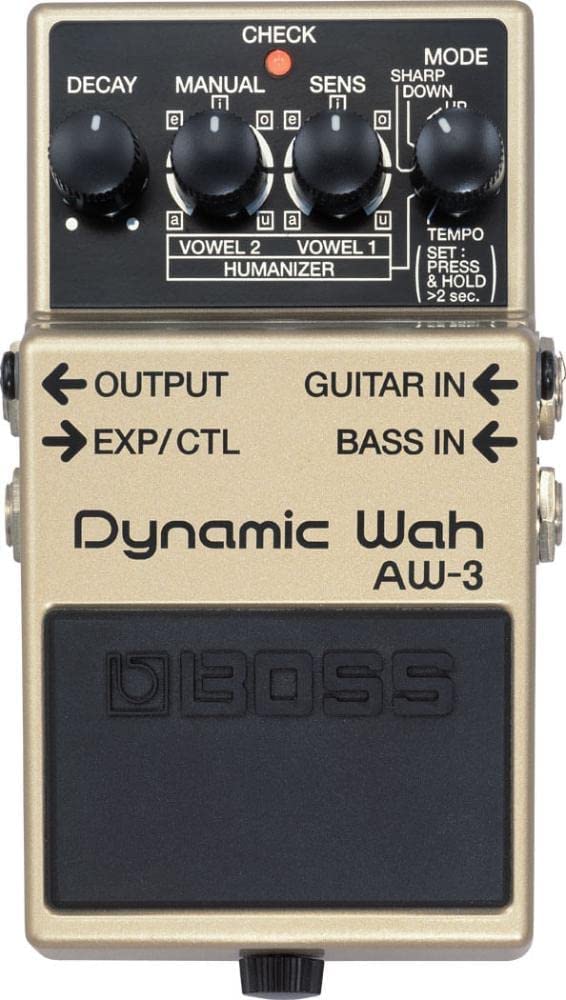
Boasting a classic style and a multicolored finish, the Boss AW-3 Dynamic Wah Pedal is a compact and versatile music gear that adds a unique character to your sound.
Tailored for both guitar and bass, this pedal introduces an array of classic auto-wah and dynamic wah effects.
One standout feature is the intriguing “Humanizer” effect, capable of mimicking human vowel sounds, bringing an inventive twist to your performances.
Another distinctive trait of this dynamic wah pedal is its flexible envelope filter, allowing musicians to control the tempo manually.
Additionally, the pedal has a dedicated input for bass guitars, expanding its functionality.
Despite its compact size (5.95 x 3.75 x 2.85 inches) and lightweight (1.3 pounds), the AW-3 doesn’t compromise on delivering robust, high-quality sound.
Users also have the option to power it with an AC adapter or batteries.
Constructed with durability, this pedal is ready to hit the road with you, creating unforgettable performances.
- My Review
Immersing myself into the world of wah effects with the Boss AW-3 Dynamic Wah Pedal, I discovered an adventure in sound that, while full of potential, could challenge even seasoned pedal pros.
At first glance, the pedal’s chameleon-like qualities draw you in.
Its vibrant multicolored casing is as varied as the tones it promises.
Sleek, compact, and solid, it’s a testament to Boss’s legacy of crafting sturdy, road-ready gear.
Delving into its features, the AW-3 presents a palate of classic auto-wah and dynamic wah effects.
As I explored each one, the pedal’s flexibility became more and more apparent.
As a result, I could dial in a distinct tone, whether for a smooth jazz session or a funky bass breakdown.
However, the real star of the show here is the “Humanizer” effect.
It’s like your guitar or bass suddenly learned to talk!
Mimicking human vowel sounds added a quirky, expressive edge to my playing.
Despite its novelty, it took a bit of time to tame this wild beast of an effect, requiring just the right balance to ensure it didn’t overpower the overall sound.
The envelope filter with its tempo control was one feature that demanded my attention.
The ability to directly dictate the effect’s rhythm was a novel experience.
However, wrangling this feature into submission was no walk in the park, requiring patience and experimentation.
Switching between bass and guitar, I found the AW-3 accommodating, with a dedicated bass input.
Still, I noticed some tonal shifts when the pedal came into play, especially with the bass.
Finally, let’s talk about power.
With an AC adapter or batteries, it caters to various gig situations.
Just remember, using batteries can influence the sound as they run low.
- Pros:
- Great auto wah for bass and guitar.
- Adjustable and well-made.
- Wide range of wah effects.
- Cons:
- May require time to master usage.
- Difficult to fit into compact setups.
- Not ideal for replicating certain sounds.
So, the AW- overall-3, with its wide array of effects, sturdy build, and flexible power options, is a dynamic powerhouse.
Yet, it’s a wild ride, so be prepared for some thrilling sonic exploration!
Here are the ratings I’ll give to the Boss AW-3 Dynamic Wah Pedal:
My final verdict is that the Boss AW-3 Dynamic Wah Pedal is a versatile and well-made effects pedal suitable for both bass and guitar players.
It offers many auto-wah and dynamic wah effects and the unique “Humanizer” effect for vowel sounds.
However, it may require some time and experimentation to utilize its features fully, and its larger size might pose challenges for compact pedal setups.
Musicians searching for dynamic wah effects will find this option a reliable choice.
Ibanez WH10 V3 Wah Pedal
Unparalleled sound with Ibanez WH10 V3 Wah Pedal.
Vox AC30HW2X is a 30W guitar amp with two 12” Celestion V-Type speakers, two channels, and Tone Cut and Volume controls. It has the signature Vox mid-range punch and built-in reverb and tremolo, giving guitarists a classic sound with enhanced control.
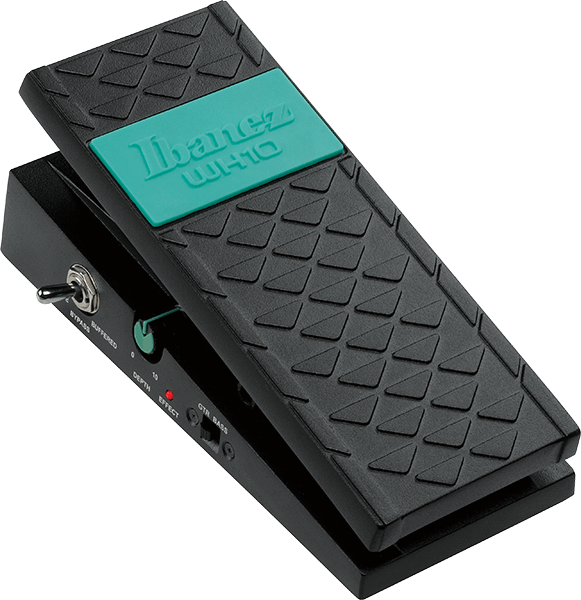
The Ibanez WH10 V3 Wah Pedal is a versatile and modern wah guitar effect pedal with many useful features.
Crafted in a sleek black design, it offers a high-quality and unique wah sound that stands out.
In addition, the pedal incorporates a switchable bypass mode that allows for more nuanced use and a multiple feedback op-amp circuit responsible for producing smooth and distinctive wah tones.
Measuring 1 x 10 x 5 inches, this lightweight pedal (0.82 kgs) is portable yet durable for various uses.
The pedal includes a handy range switch to toggle between different frequencies to customize your sound further.
Moreover, the depth knob enables you to control the intensity of the effect – an essential aspect for musicians striving to find their unique wah sound.
Reflecting quality and reliability, this Ibanez Wah product aims to provide fantastic results for guitar lovers who enjoy experimenting with sounds and textures.
- My Review
Having tried the Ibanez WH10 V3 Wah Pedal, I must admit it exceeded my expectations regarding innovative features, performance, and versatility.
This sleek, black wah pedal stood out from the crowd and manifested exceptional craftsmanship.
As a bonus, it was quite portable, weighing only 0.82 kilograms, making it a breeze to transport to and from gigs.
Getting my hands on this pedal opened up a new world of tones, as the multiple feedback op-amp circuit produced some of the smoothest and most distinctive wah flavors I’ve ever encountered.
Twiddling the handy range switch allowed me to oscillate between diverse frequency spectrums, and the depth knob offered even more control over the intensity of the effect – an absolute treat when searching for that perfect wah sound.
While I was thrilled with the tonal options, what impressed me most was the switchable bypass mode, which gave me a significant amount of freedom when alternating between clean and affected guitar signals.
It’s not often that I find a product that provides so much flexibility and top-notch results!
Nonetheless, no pedal is flawless, and the Ibanez WH10 V3 has quirks.
The first thing that struck me was the pressure to engage the pedal using the on/off button.
Let me tell you, it requires a strong foot.
Although it led to a solid connection, my weaker stabs at the pedal did not produce the desired result.
Additionally, the performance could be somewhat inconsistent sometimes, with the wah effect not always sitting perfectly in the mix.
Despite these minor setbacks, the Ibanez WH10 V3 Wah Pedal left me awe-struck with its stellar performance and customizable features.
Here are the ratings I’ll give to the Ibanez WH10 V3 Wah Pedal:
Anyone keen on incorporating this unique and multidimensional wah effect into their playing repertoire is in for quite the ride.
So, heavy-footed musicians out there, rejoice – this pedal is for you!
- Pros:
- Multiple feedback op-amp circuit.
- Customizable wah effect & range.
- Portable and sleek design.
- Cons:
- Stiff on/off button.
- Inconsistent performance at times.
- May not suit all playing styles.
My final verdict is that the Ibanez WH10 V3 Wah Pedal certainly offers a wealth of features, a unique and customizable tone, and a sleek design for both advanced and beginner guitarists.
Although the pedal’s occasional inconsistent performance and stiff on/off button may be bothersome for some users, it remains a solid choice for musicians seeking an array of inventive tones within their wah collection.
Boss PW-3 Wah Pedal
Rugged, space-saving design with pro wah tones and dual-mode LEDs.
The BOSS PW-3 Wah Pedal offers a professional-grade wah sound in a compact design, featuring two modes for a variety of tones. Its die-cast aluminum chassis is substantial and the long, smooth pedal action is highly responsive. LEDs on each side of the pedal make it easy to see when the wah is activated.
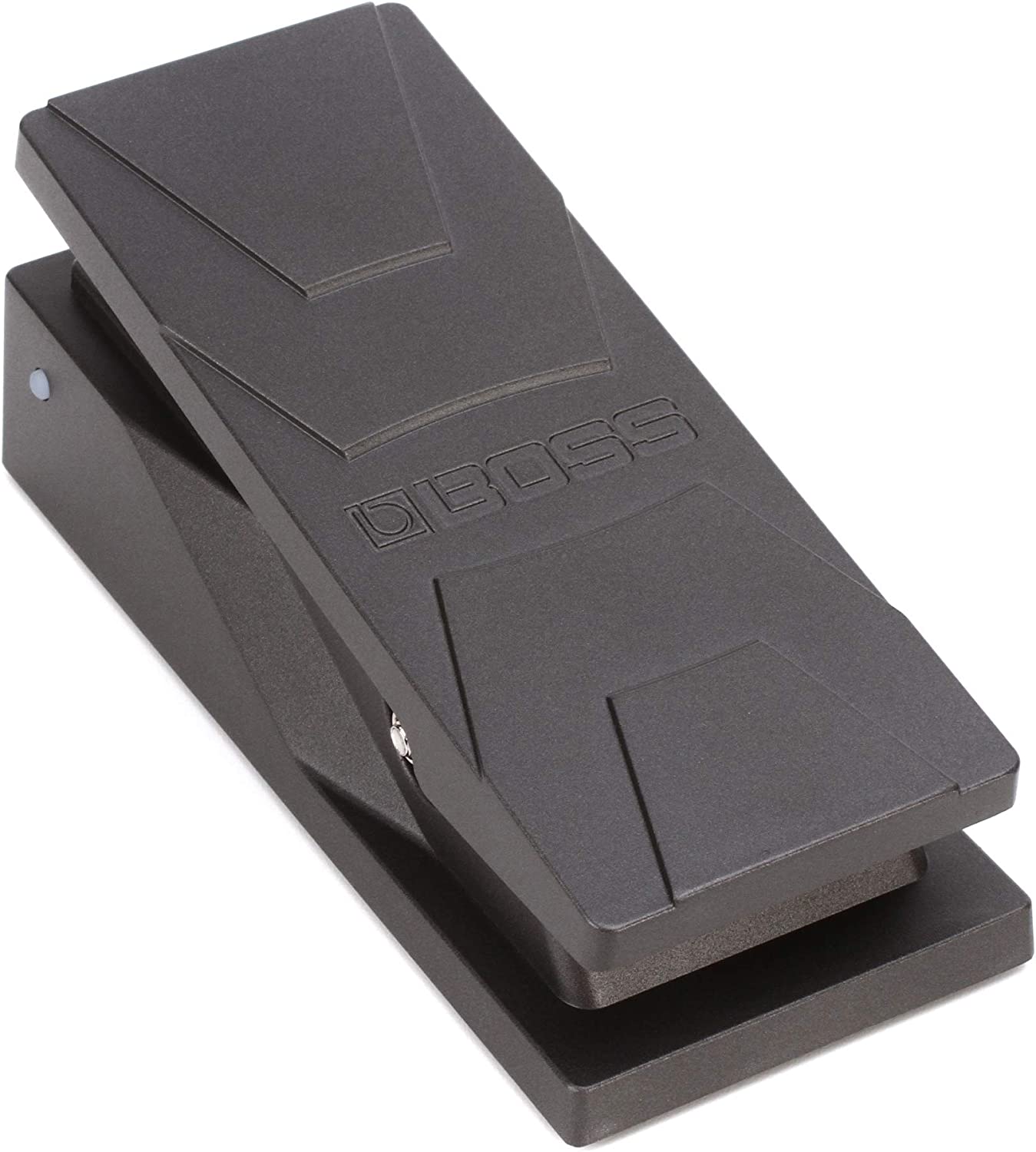
The Boss PW-3 Wah Pedal is a compact and versatile electric guitar effects pedal designed to deliver professional Wah tones while saving space on your pedalboard.
This all-analog pedal features Rich and Vintage modes, allowing you to switch between a full, unique wah sound that maintains low-end definition and a classic wah tone.
Constructed with a die-cast aluminum chassis, the PW-3 is durable and responsive, offering a smooth pedal action that feels great underfoot.
One of the standout features of this pedal is the inclusion of status LEDs on each side, making it easy to see when the effect is activated, even with your foot covering the pedal.
Developed by BOSS, the PW-3 is perfect for musicians who want a high-quality wah pedal that doesn’t compromise functionality or feel while fitting comfortably on their pedalboard.
In addition, its compact design and practical features make it an excellent choice for guitarists seeking a reliable and versatile wah pedal.
- My Review
After exploring the Boss PW-3 Wah Pedal, I’ve got to say it truly adds a new dimension to my electric guitar’s sound.
With its two distinct wah modes – Rich and Vintage – this pedal opens up doors for creative expression.
While the Rich mode presents a full-sounding wah experience, maintaining a perfect balance in the low end, the Vintage mode transports you back to those classic, well-loved wah vibes.
One might think its compact size would compromise comfort and playability, but I found that the PW-3 strikes a harmonious fusion between practicality and usability.
Thanks to its die-cast aluminum chassis, this pedal is rugged and stands up to the test of time while still being responsive and feeling great underfoot.
A stand-out feature I appreciated is the side-mounted status LEDs, providing a clear visual cue that the effect is activated even when my foot’s engulfed in wah-wielding action.
No more guessing if it’s on or off – these LEDs remove doubt.
However, not everything is perfect with this pedal.
The bypass tone could improve since it seems to cut off those higher frequencies, which is perplexing considering Boss’s track record for excellent buffer circuits.
Additionally, the switch engagement feels stiff and lacks the assurance of a positive engagement.
Finally, a more prominent click on disengaging and engaging might be more user-friendly.
Here are the ratings I’ll give to the Boss PW-3 Wah Pedal:
Despite its shortcomings, the Boss PW-3 Wah Pedal proves to be a strong contender in the realm of effect pedals.
It offers versatility, a compact yet practical design, and adds just the right amount of wah magic to help you stand out in any live or recording scenario.
- Pros:
- Rich and Vintage wah modes.
- Compact, pedalboard-friendly design.
- Responsive LED indicators.
- Cons:
- BYPASS tones limit high range.
- Slightly stiffer switch engagement.
- Not positively engaged.
My final verdict is that the Boss PW-3 Wah Pedal is a solid choice for guitarists who desire a versatile, compact, and durable wah pedal with impressive tones and features.
Despite a few areas that could use improvement, this pedal’s overall performance and value make it a worthy investment.
JIM DUNLOP Standard Wah Pedal
Legendary tone with durable construction and easy powering options.
The Dunlop Cry Baby Wah is an iconic guitar effect pedal, providing a lush, expressive sound with focused highs and an aggressive wah. Built to last with a heavy-duty die-cast housing and Hot Potz potentiometer tested to one million cycles.
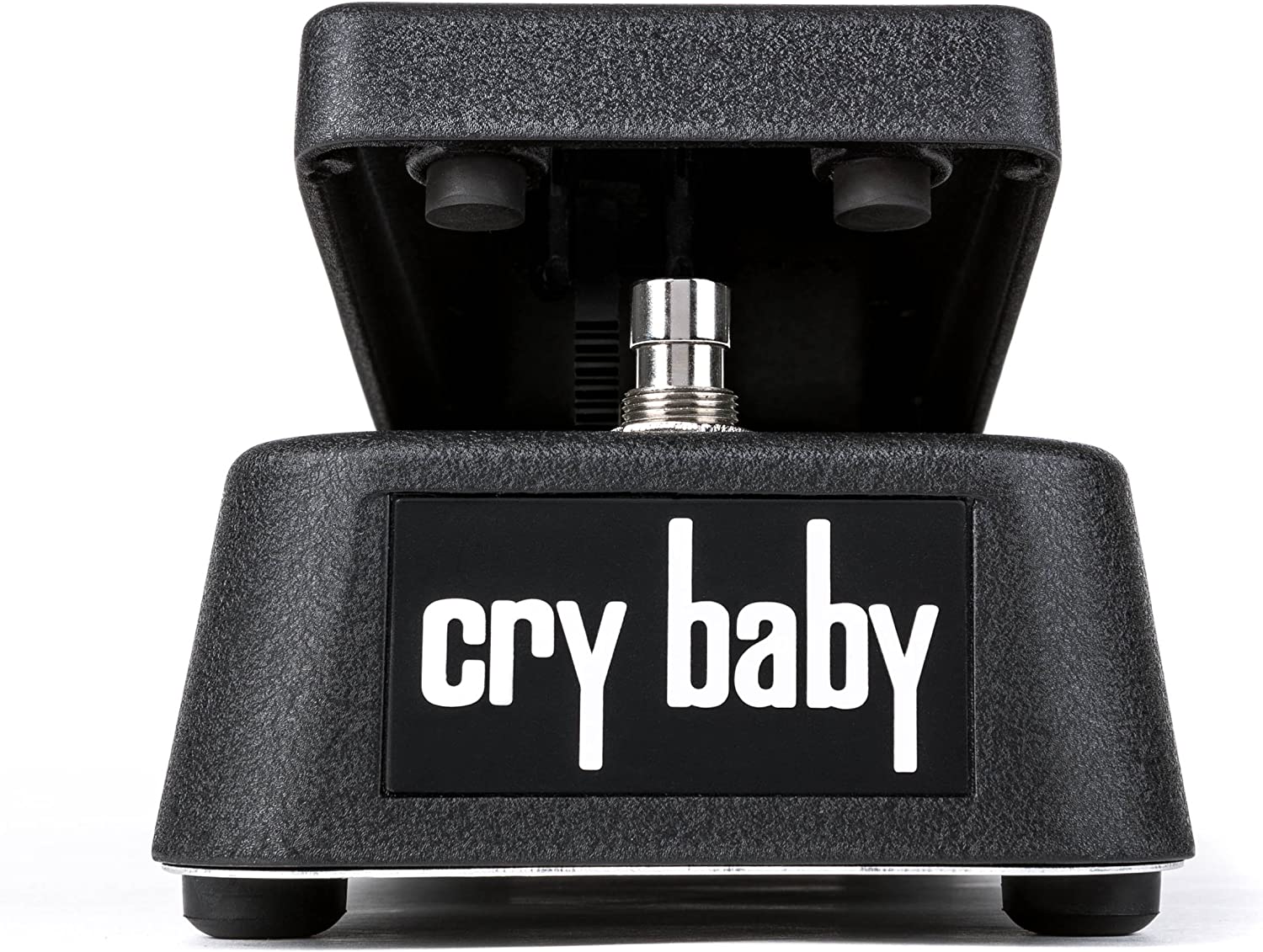
The JIM DUNLOP Standard Wah is a sturdy and popular guitar pedal known for its sleek black design and durable die-cast body.
Measuring 10 inches by 4 inches by 2.5 inches in size won’t take up too much space on your pedalboard.
Weighing 3.7 pounds, it’s solidly built and designed to withstand wear and tear from frequent use.
The wah-wah pedal is operated using an ECB-03 AC adapter, which must be purchased separately or powered by a standard 9-volt battery.
The manufacturer, Dunlop, is a trusted name that has been creating musician-friendly gear for several decades, indicating the quality of the product.
Musicians appreciate this well-loved standard wah pedal’s simplicity, reliability, and classic sound.
The product’s features don’t include multiple-tone knobs or complicated mechanisms.
Instead, it delivers an effective rocking action for players who can appreciate the simplicity of a Standard Wah configuration without added complications.
- My Review
Upon spending some time with the JIM DUNLOP Standard Wah, I can confidently state that this investment was worthwhile.
This wah-wah pedal has left a considerable impression, from its sturdy die-cast construction to a simple yet highly effective design.
Slightly bulky with dimensions of 10″x4″x2.5″, I found it manageable and durable on my pedalboard.
Upon powering the pedal with either an ECB-03 AC adapter or a 9-volt battery (which was easy to swap between), I dived right into tinkering with its broad array of wah options.
With each foot stroke on this pedal, I discovered that quintessential wah sound that so many seek out.
In addition, the reliable, one-click on-and-off switch allowed me to play uninterrupted, making transitions seamless throughout jams and performances.
One observation worth mentioning is the pedal’s strong, smooth, rocking action.
This smooth motion ensured no unintended skips or jitters, allowing me to glide precisely through the entire wah range.
Though I had minor concerns over the absence of tone knobs or multiple switches, the simplicity of the pedal turned out to be its greatest asset.
Having just one switch and a rocking pedal footprint allowed me to zone in on perfecting my wah technique without getting lost in a labyrinth of settings.
The JIM DUNLOP Standard Wah did exhibit some minor shortcomings, such as a more defined range of flexibility with tone shaping parameters or a hardware issue (that could arise in isolated cases and can be attended to by Dunlop Support).
Here are the ratings I’ll give to the JIM DUNLOP Standard Wah Pedal:
However, they do not diminish the overall experience provided by the pedal.
After playing with multiple Wah pedals in the past, I’d conclude that the simplicity offered by this pedal, paired with its durable construction combined with that signature, classic wah sound, puts the JIM DUNLOP Standard Wah amongst my recommendations for a dependable and delightful choice.
- Pros:
- Sturdy die-cast construction.
- Classic wah sound.
- User-friendly, simple design.
- Cons:
- Limited tone shaping options.
- Potential isolated hardware issues.
- Bulky dimensions.
My final verdict is that the JIM DUNLOP Standard Wah is a solid choice for guitarists seeking a user-friendly, classic-sounding wah pedal, despite some minor drawbacks in versatility and size.
This pedal’s durable construction, performance, and value make it well worth considering for musicians of all levels.
What exactly is a wah pedal?
A wah pedal, also known as a wah-wah pedal, is a type of guitar effects pedal that creates a unique filtering effect by manipulating the tone and frequencies of the guitar’s original signal.
This signature “wah-wah” sound emulates the human voice, providing a vowel-like “wah” effect and allowing the guitarist to add an extra layer of emotion and expressiveness to their playing.
First gaining popularity in the late 1960s, the wah pedal has been a staple of guitar-driven music, featuring heavily in rock, funk, blues, and various other genres.
At the core of the wah pedal is a filter circuit consisting of an inductor, capacitors, and resistors, which shape and modulate the guitar signal’s frequency response.
By controlling the peak resonant frequency of this filter, the guitarist can sweep the tone through a wide range of frequencies.
A foot-operated rocker pedal achieves this filter sweep.
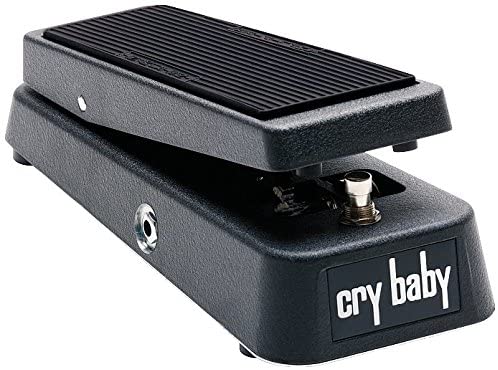
The more the pedal is pushed forward, the higher the frequency peak; when rocked back, it shifts the frequency peak into the bass range.
One key component that influences the sound character of a wah pedal is the inductor, which is part of the resonant circuit.
Various types of inductors are used in wah pedal designs, each offering different response characteristics and tonal qualities.
Some common inductor types include the classic halo, Fasel, and a stack of dimes inductors, each delivering different tonal variations.
Two other fundamental wah pedal variations include the optical and switchless designs.
As their name suggests, optical wah pedals utilize optical technology such as an infrared sensor instead of traditional potentiometers, ensuring smoother operation and reduced wear and noise issues.
On the other hand, switchless wah pedals abandon the bypass switch mechanism found in classical models to facilitate a quicker engagement and disengagement of the effect – often through a pressure-sensing system.
Over the years, wah pedals have seen many advancements, such as the addition of true bypass switch options, ensuring that the pedal does not affect the guitar’s signal quality or tone when disengaged, adjustable Q-controls, allowing customization of the wah’s range and frequencies, and the flexibility to choose between inductor variations and gain switches to fine-tune the overall response and output of the pedal.
The Dunlop Cry Baby is one of the pioneering wah pedals that stands the test of time.
This pedal, first released in the mid-1960s, became associated with famous artists such as Jimi Hendrix, Eric Clapton, and David Gilmour.
In addition, other respected industry brands have released their renditions of Wah pedals.
From the Vox V847, Ibanez WH-10, Morley Bad Horsie, and Fulltone Clyde Standard to the Xotic XW-1, guitarists have a wide range of wah pedals to choose from based on their tonal preferences and playing styles.
It’s important to note that wah pedals are not exclusive to electric guitars.
Dedicated wah pedal models cater to bass guitars, typically featuring the ability to handle lower frequencies in response to the instrument’s lower register.
What should you consider when choosing a wah pedal?
When choosing the perfect wah pedal for your setup, several factors affect your ultimate playing experience and overall satisfaction.
Delving into these various factors will ensure you find the ideal wah pedal that meets your expectations and musical demands.
– Sound quality:
The primary consideration while choosing a wah pedal must always be the sound quality it produces.
The tone is a matter of personal preference.
When exploring different models and brands, you should focus on the range and sensibility of the wah effect, the smoothness of the filter sweep, and the overall symmetry it creates with your guitar rig.
Some wah pedals offer a more vintage and classic tone, while others may have a more modern and versatile sound.
Take note of the inductor type and other components when assessing sound quality, as they could affect the performance of the wah pedal.
– Controls and features:
Different wah pedals come with varying controls and features that can affect the overall performance and ease of use.
While considering your options, look out for features like adjustable Q controls, which allow customization of the wah’s range and frequencies, switchable inductors that ensure variety in tonal combinations, and options for built-in gain or boost switches, as they may contribute to the wah’s ability to cut through the mix.
– Analog vs. Digital:
As both analog and digital wah pedals have their merits, weighing your priorities before making your choice is crucial.
Analog wah pedals might deliver a more organic and natural sound, with greater warmth and vintage character; however, they may lack consistency and reliability due to critical components like potentiometers.
On the other hand, digital wah pedals provide improved consistency and feature sets, with some models replicating the analog style closely.
In addition, they often come with additional digital settings that allow further customization and versatility.
– Build quality and durability:
A robust and well-built wah pedal is more likely to endure regular use and wear, especially with the foot control mechanism.
When considering build quality, consider the materials used, with rugged metal construction typically preferable to weaker plastic ones.
It would be best to look for smoother mechanisms, such as optical sensors, which can help reduce noise and potential repair or replacement costs with moving parts.
Additionally, factor in the weight and compactness of the wah pedal as it might impact its compatibility on your pedalboard and ease of transportation.
– Presets and versatility:
Whether you’re an exploring guitarist who seeks a wide palette of tonal options or a player who requires a few specific tones, the pedal’s preset capabilities could be a significant factor.
Some wah pedals may offer preset options or even allow users to create their custom presets, further increasing the already expanded capabilities of modern wah pedals.
This versatility is invaluable to musicians seeking a multipurpose pedal that can adapt to different musical settings.
– Brand reputation:
Knowing a brand’s reputation can offer insights into their wah pedals’ expected performance and quality.
Renowned brands such as Dunlop, Vox, and Morley have a strong history of producing reliable and time-tested wah pedals.
In addition, reputable brands have the advantage of extensive research and development, which contributes to creating pedals that cater to diverse preferences and playing styles.
– Price and budget:
A wide variety of wah pedals are available at different prices.
While higher-priced wah pedals are often synonymous with advanced features and enhanced build quality, some affordable options still deliver excellent sound quality and reliable performance.
Determine the budget you are comfortable with and seek out the best balance of sound quality, durability, and features.
– Reviews and recommendations:
Lastly, take the time to read reviews, watch videos, and consult fellow musicians regarding their wah pedal experience.
Listening to audio clips and gathering recommendations from trusted sources provides invaluable insight into the expected performance and sound of the wah pedal, avoiding potential dissatisfaction or buyer’s remorse.
How to use a wah pedal?
Many people should learn how to use a wah pedal properly.
It might be hard at first to make it sound like something you’re proud of; however, as time passes and as you practice more and more, it will become easier and natural.
Here are some tips that you can start using today to make your wah sound more interesting and appealing:
– Emphase the right notes
The best thing about doing this is allowing you to add more expression to your playing, especially if we’re speaking of a solo section.
What I mean by emphasizing the “right” notes is that you shouldn’t be going crazy on some random note in your solos, rather, use the wah to add more variety and dynamics.
As guitarists, most, if not all of us, tap our feet when we play to keep up with the song’s tempo; if you already do this naturally, then using the wah in its most basic form will be very simple for you.
For example, let’s say that you’re playing a very slow and emotional solo or a Santana’s Europa type track, and in some parts, you’re expected to hold a note for more than 1 or 2 bars.

Although in this simplified version of Europa, you’ll only have to use vibrato, in any similar case, since you’re holding the same note, a wah would be ideal to prevent it from sounding dull or boring and to add a vocal feel to the music.
– Use it as a filter effect pedal
The best thing about having a wah pedal is that it can be used as much more than just a simple wah pedal.
For example, you can use it as a filter to build tension before you reach a new section of a song or as a way to add more low-end or high-end to your guitar tone.
When you put your foot on a wah pedal, you have several different options:
- If your wah is moved all the way back (or up), the pedal can serve as a low-pass filter. This means that low frequencies will pass through and higher frequencies will be blocked.
- If your wah is moved all the way forward (or down), the pedal can serve as a high-pass filter. This means that you’ll allow more treble in your signal and lower frequencies will be blocked.
- Lastly, when you move the pedal back and forth, it will create a combination of both, low and high frequencies that will be cut off at whatever speed you want them to; this is what we call the “wah effect.”
If a certain part of a song doesn’t need a full wah effect but still lacks some variety and uniqueness, then by playing with these options, you can allow yourself to create something interesting.
Let’s watch this YouTube video by Paul Davids which talks about all things wah pedals:
As you can see, at 1:10, he allows us to see the exact frequencies being cut off in real time as he moves his wah-wah pedal back and forth and then completely turns it off.
On the flip side, he’ll also demo some of the best ways to use a wah pedal and show us how to make it more appealing and engaging to our listeners.
– Add a consistent tremolo effect
Another great way to use a wah pedal is to use it as a tremolo effect.
In musical terms, a tremolo is:
A wavering effect in a musical tone, produced either by rapid reiteration of a note, by rapid repeated slight variation in the pitch of a note, or by sounding two notes of slightly different pitches to produce prominent overtones.
Now, if you don’t know much about effects pedals or that simply didn’t sound very clear, let’s look at what an actual tremolo pedal sounds like.
This video is a demo of the BOSS TR-2 Tremolo Pedal, and as you can hear, once the pedal is activated, it pretty much sounds like a vibrating and trembling noise.
Although the effects won’t sound the same, a slow and moderate tremolo is possible with a wah-wah pedal.
To do this, move the pedal back and forth as fast as possible while keeping up with the tempo.
If you don’t want it to sound too energetic and forceful, then by restraining yourself from pushing the wah pedal all the way forward, you will have control over the depth and intensity of the sound.
– Make percussive rhythms
When you strum your muted guitar strings and wave the wah pedal back and forth, the sound produced will resemble a percussion instrument.
If you have thought of adding defining and interesting sounds with your wah, this technique will help you do just that.
Jimi Hendrix was the most popular guitar player known to have heavily incorporated this into his songs.
Let’s take a look at this live performance of “Voodoo Child” by The Jimi Hendrix Experience in 1970:
As you can hear, he doesn’t do this to the point where it becomes annoying or boring, but rather as a great way of adding dynamics and uniqueness that catch the listener’s ear right away.
Needless to say, the quality in which this gets executed highly depends on your strumming abilities, so in this case, the wah is simply adding an extra layer of interestingness.
– Build up a certain part of a song
Just like I explained above, depending on whether the wah pedal is all the way back or all the way forward, this can act as both a low-pass filter and a high-pass filter.
In modern music, with the rise of electronic music, we’ve seen build-ups have more acceptance and use just before the drop or chorus sections of songs.
A build-up in music terms:
Is the transitioning from the breakdown or bridge of a song to the drop/chorus.
In other words, this is the part where a song’s energy builds momentum, makes you wait for the better, and is usually the most important section of the track.
Although not ideal, you can create a similar effect with a wah-wah pedal!
Just cut all the low frequencies by moving the pedal back and slowly start pushing it forward as you keep playing your guitar.
Once you’ve reached the point where the next section is about to start, you can turn the wah pedal off and play as you normally would.
How to order pedals on a pedalboard?
There is no one-size-fits-all approach to ordering pedals on a pedalboard, as the optimal arrangement largely depends on the specific sound you’re aiming for.
Usually, though, you will see guitar players mostly agreeing with this order:
Tuner > Filters/Dynamics > Pitch-based Effects > Overdrive/Distortion > Modulation > Time-based Effects > Looper
Aside from that, some general guidelines can help you achieve a balanced and versatile setup.
Let’s talk in detail about the order we just mentioned, but feel free to experiment and adjust to your own preferences:
- Tuner: Place your tuner pedal first to ensure your signal is in tune before passing through the other pedals.
- Filters and dynamics: Wah-wah, envelope filters, compressors, EQs, and noise gates should come next. These pedals affect your sound’s dynamic and tonal aspects, so it’s best to place them early in the chain.
- Pitch-based effects: Octavers, harmonizers, and pitch shifters should come after filters and dynamics since these pedals alter the pitch of your signal and work best with a clean, unprocessed sound.
- Overdrive and distortion: Overdrive, distortion, and fuzz pedals typically come next. They shape your guitar’s core sound, and placing them before most other effects ensures that those effects receive a strong, consistent signal.
- Modulation effects: Chorus, flanger, phaser, and tremolo pedals should be placed after overdrive and distortion effects. We do this to allow these pedals to add depth and movement to your sound without becoming overly distorted or overbearing.
- Time-based effects: Delay and reverb pedals should be placed towards the end of your signal chain. This allows them to create a sense of space and depth around the other effects, simulating the sound of a room or hall.
- Looper: If you use a looper pedal, it should be placed last in the chain. This ensures that you’re looping the entire signal, including all the effects you’ve applied.
Remember, these are just general guidelines and what generally works and sounds good.
The most important thing is to experiment and find the arrangement that best suits your personal sound and style.
For example, here’s one pedalboard signal chain that I always use:
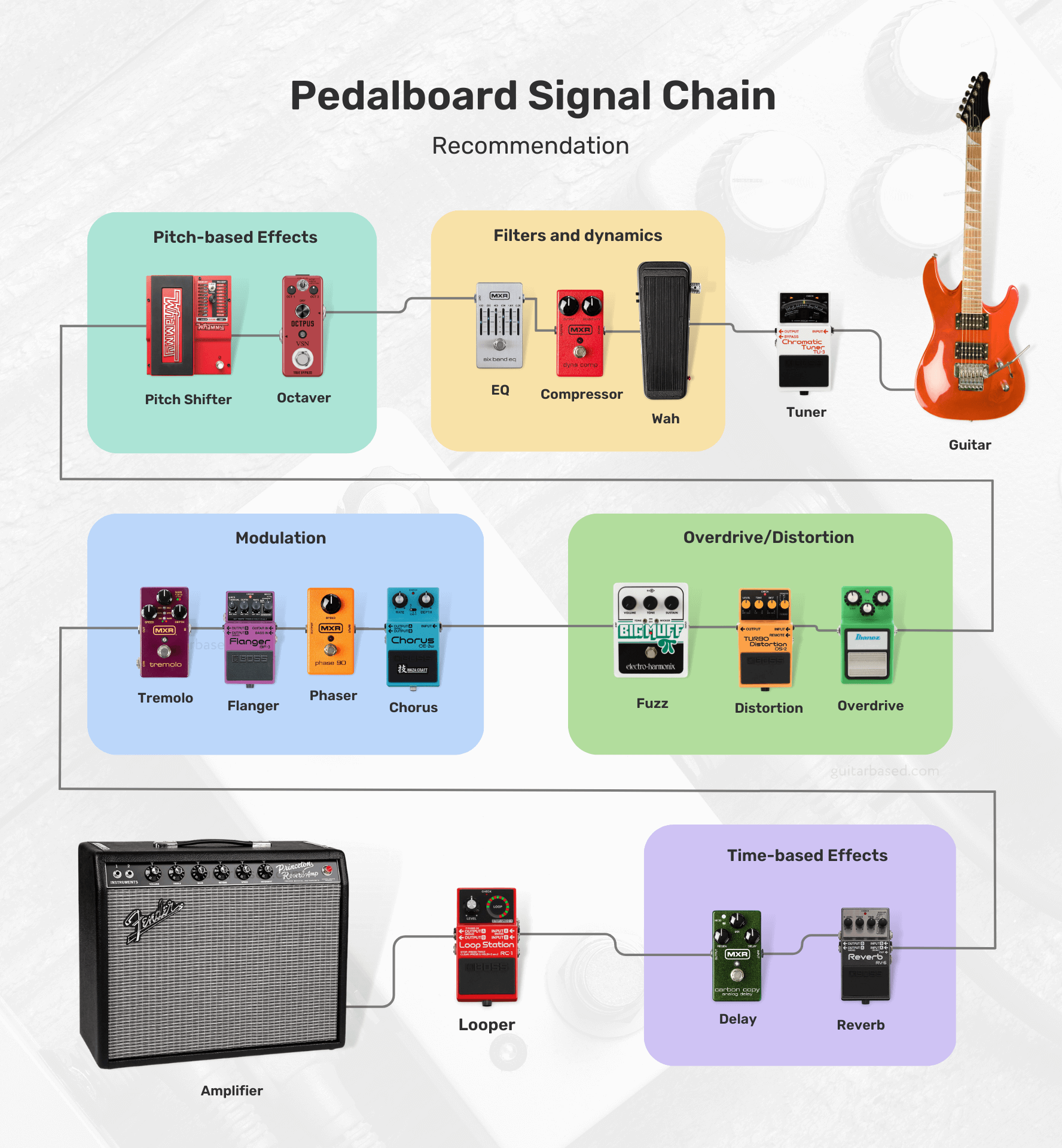
Feel free to swap the order of pedals, try different combinations, and test out unconventional setups until you find the one that works best for you.
For those interested, I’ll leave you with most of the possibilities that you’ll encounter and how to order them.
- Tuner
- Filters/Dynamics:
- Volume
- Wah
- Auto-Wah
- Compressor
- Noise Gate
- EQ (Equalizer)
- Pitch-based Effects:
- Octaver
- Harmonizer
- Pitch Shifter
- Overdrive/Distortion/Fuzz:
- Boost
- Overdrive
- Distortion
- Fuzz
- Modulation:
- Chorus
- Phaser
- Flanger
- Univibe
- Vibrato
- Tremolo
- Time-based Effects:
- Delay
- Echo
- Reverb
- Synth/Bitcrusher:
- Synth
- Bitcrusher
- Acoustic Simulator
- Multi-Effects
- Utility:
- Buffer
- A/B/Y Switcher
- MIDI Controllers
- Looper
Boutique vs. Mass-Produced pedals
Boutique pedals are generally built with higher-quality components and craftsmanship, resulting in better durability and longevity.
These pedals often feature unique and innovative designs, providing a wider range of tones and effects that may not be available in mass-produced options.
Here are a few examples of boutique pedals:

All the manufacturers also tend to have a more personal approach, with better customer service and the ability to customize pedals according to the user’s preferences.
However, boutique pedals are usually more expensive due to the smaller scale of production and the use of premium components.
Mass-produced pedals, on the other hand, are more affordable due to their larger scale of production and the use of cost-effective components.
These pedals are widely available and offer a range of popular effects, making them accessible to a larger audience.
Here are a few examples of mass-produced pedals:

The quality control for mass-produced pedals can vary depending on the brand and model, but many are reliable and offer good value for the money.
As for one of the downsides, you’ll find that mass-produced pedals may not have the same level of uniqueness or innovation as boutique options.
On the other hand, they may not provide the same level of customer service or customization options.
The choice between boutique and mass-produced pedals depends on your personal preferences, budget, and desired sound.
If you’re looking for unique tones, higher-quality components, and a more personal experience, boutique pedals may be the way to go.
But I would say, for those who are on a budget and need access to popular effects, mass-produced pedals might be a better fit.
It’s worth trying out both types to see which best suits your needs and playing style.
How much should you spend on a guitar pedal?
If I were in your position, I would first determine my budget and specific needs before deciding how much to spend on a guitar pedal.
For beginners, it might be more reasonable to start with affordable, mass-produced pedals to explore different effects without spending too much.
Guitar pedals can range in price from around $30 to over $400, depending on the brand, quality, and complexity of the effect.
As your skills and understanding of your preferred tone develop, you can gradually upgrade to higher-quality or boutique pedals.
One thing I would do is consider which effects are essential to your playing style and prioritize purchasing those first.
Allocating a larger portion of your budget to the most important pedals might be a wise choice, especially if you only need a few basic effects.
However, if you require a wide array of effects, you may want to consider more budget-friendly options or multi-effects units.
Keep in mind that higher-priced pedals often come with better build quality, unique features, and improved sound quality.
But I would also say that price is not always directly correlated with quality or suitability for your needs.
Sometimes, a more affordable pedal can deliver the exact sound you’re looking for, while a higher-priced option might not meet your expectations and are only expensive because of the brand reputation.
Can you use a guitar pedal with a bass guitar?
You can certainly use a guitar pedal with a bass guitar.
But it’s crucial to be aware that some guitar pedals may not be specifically designed to accommodate the frequency range of a bass guitar.
This could result in a less-than-ideal performance or an altered tone that might not be what you were expecting.
If you’re feeling adventurous and eager to experiment with your sound, don’t hesitate to connect your guitar pedals to your bass guitar.
This can be a fun way to explore different sonic possibilities, and you might even stumble upon some unique tones that complement your playing style perfectly.
Using a guitar pedal with a bass guitar may not always produce the desired results.
In some cases, the low-end frequencies might be lost, or the effect could sound too harsh or muddy.
To avoid these issues, you could consider looking into pedals that are specifically designed for bass guitars.
These pedals are engineered with the bass frequency range in mind, ensuring that your low-end remains intact and the effect sounds as intended.
In addition to bass-specific pedals, there are also multi-effects processors and pedals that cater to both guitar and bass players, offering a wide range of effects and tonal options.
These versatile units can be a great solution if you play both instruments and want a single device to cover your needs.
How to properly power your pedals?
When it comes to powering your pedals, you want to make sure you’re doing it right to avoid any noise issues or potential damage.
First, check each pedal’s power requirements, which you can usually find in the manual or on the pedal itself.
You’ll want to pay attention to the voltage (usually 9V, 12V, or 18V) and current (measured in milliamps or mA).
Now, you’ve got a few options for powering your pedals.
You can use individual power supplies or batteries for each pedal, but that can get messy and inconvenient.
I’d recommend going for a pedal power supply or an isolated power brick.

For example here are a few ones I recommend:
- Voodoo Lab Pedal Power 2 Plus Isolated Power Supply (My favorite)
- Rowin PW-1 Guitar Pedal Power Supply (Cheapest)
These babies can power multiple pedals at once, and the isolated outputs help prevent noise and ground loop issues.
Just make sure the power supply you choose can handle the voltage and current requirements of all your pedals.
When you’re connecting everything, use good quality power cables and keep them neat and tidy to avoid a tangled mess.
You might even want to use cable ties or cable organizers to keep everything in order.

An avid storyteller and music lover that devotes all his free time to mastering the art of playing guitar. I’ve played acoustic for 6 years, and recently started playing electric guitars. Currently playing an Epiphone SG Special!

